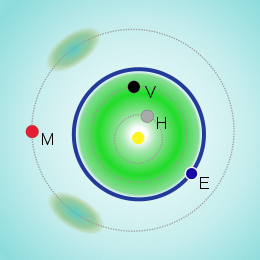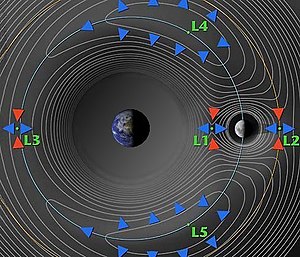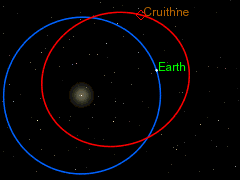Note: only objects of note have been included in the table of contents. For more information on comets, please use the following links: list of periodic comets and list of non-periodic comets.
Size: 109 times bigger than the Earth
Type: main-sequence yellow dwarf
Distance to Milky Way Core: 27,200 ly
Orbital period: 2.25–2.50x108 years
Nearest Major Star System: Eden
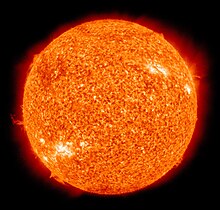
Distance to Earth: 1 AU
Travel Time to Earth: 8 min 19 s at light speed
A nearly perfect spherical ball of hot plasma, with internal convective motion that generates a magnetic field via a dynamo process. It accounts for about 99.86% of the total mass of the Solar System.
Chemically, about three quarters of the Sun's mass consists of hydrogen, whereas the rest is mostly helium, and much smaller quantities of heavier elements, including oxygen, carbon, neon and iron.
The Sun formed approximately 4.567 billion years ago from the gravitational collapse of matter within a region of a large molecular cloud. The Sun is roughly middle age, and has not changed dramatically for four billion years. It will remain fairly stable for four billion more years.
The Sun does not have a definite boundary, and in its outer parts its density decreases exponentially with increasing distance from its center. For the purpose of measurement, however, the Sun's radius is considered to be the distance from its center to the edge of the photosphere, the apparent visible surface of the Sun.
▲ Top ▶ Locations Index
Type: rocky asteroids
Size: 100 m to 6 km
Rotation: varies
Orbital period: 0.06–0.21 AU.
 A hypothetical population of asteroids that orbit the Sun in a dynamically stable zone inside the orbit of the planet Mercury. Any vulcanoids that exist must be relatively small, and are probably located in nearly circular orbits near the outer edge of the gravitationally stable zone. They would be almost hot enough to glow red hot.
It is thought that the vulcanoids would be very rich in elements with a high melting point, such as iron and nickel. They are unlikely to possess a regolith. Vulcanoids are probably similar to Mercury in colour and albedo.
A hypothetical population of asteroids that orbit the Sun in a dynamically stable zone inside the orbit of the planet Mercury. Any vulcanoids that exist must be relatively small, and are probably located in nearly circular orbits near the outer edge of the gravitationally stable zone. They would be almost hot enough to glow red hot.
It is thought that the vulcanoids would be very rich in elements with a high melting point, such as iron and nickel. They are unlikely to possess a regolith. Vulcanoids are probably similar to Mercury in colour and albedo.
▲ Top ▶ Locations Index
Type: rocky planet
Size: 4,879.4±2.0 km (0.3829 Earths)
Rotation: 115.88 days
Orbital period: 87.969 days at 0.387 AU
Atmosphere: none
Water: ice at bottom of deep polar craters
Orbit:
No natural satellites
minimal Unified Forces presence in subsurface facilities in the Northern polar regions
the settlements on Mercury are mainly geared toward science (the study of the Sun and Mercury), communications relay, and monitoring the area closest to the Sun.
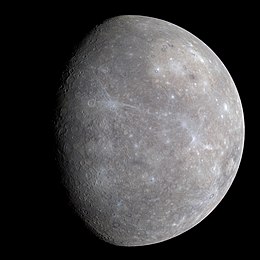 The smallest and closest planet to the Sun. Because it has almost no atmosphere to retain heat, Mercury's surface experiences the greatest temperature variation of the planets in the Solar System, ranging from -173°C at night to 427°C during the day at some equatorial regions. The poles are constantly below -93°C.
Mercury's axis has the smallest tilt of any of the Solar System's planets, but it has the largest orbital eccentricity. At aphelion, Mercury is about 1.5 times as far from the Sun as it is at perihelion. Mercury rotates in a way that is unique in the Solar System. It is tidally locked with the Sun in a 3:2 spin-orbit resonance, meaning that relative to the fixed stars, it rotates on its axis exactly three times for every two revolutions it makes around the Sun. An observer on Mercury would therefore see only one day every two Mercurian years.
Mercury's surface is heavily cratered and similar in appearance to the Moon, indicating that it has been geologically inactive for billions of years.
The smallest and closest planet to the Sun. Because it has almost no atmosphere to retain heat, Mercury's surface experiences the greatest temperature variation of the planets in the Solar System, ranging from -173°C at night to 427°C during the day at some equatorial regions. The poles are constantly below -93°C.
Mercury's axis has the smallest tilt of any of the Solar System's planets, but it has the largest orbital eccentricity. At aphelion, Mercury is about 1.5 times as far from the Sun as it is at perihelion. Mercury rotates in a way that is unique in the Solar System. It is tidally locked with the Sun in a 3:2 spin-orbit resonance, meaning that relative to the fixed stars, it rotates on its axis exactly three times for every two revolutions it makes around the Sun. An observer on Mercury would therefore see only one day every two Mercurian years.
Mercury's surface is heavily cratered and similar in appearance to the Moon, indicating that it has been geologically inactive for billions of years.
Settlements
Civilian Gov.:
Pop.: tens of thousands
Local Gov.: Unified Government
Main Leader(s): under investigation
Military:
Starport: under investigation
Top military leader: under investigation
Ship deployed in emergencies: Mariner (Bolognese Stealth Frigate)
Settlements:
Columbo (capital): 5,000 residents
Mio (2nd largest): less than 2,000
Messenger (3rd largest): less than 2,000
Rural Settlements
Small Towns: approx. 1,000 residents spread evenly, with populations that rarely exceed 200 residents. Towns are mostly located in ice-mining areas.
Orbit
no permanent facilities
Due to the high temperature variation, any ships visiting or temporarily assigned to Mercury park in the relatively shielded L2 Lagrangian point.
Location: approx. 4,635.43 km from Mercury
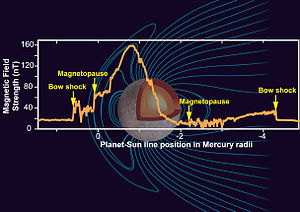 Mercury's magnetic field is approximately a magnetic dipole, and apparently global, on planet Mercury. It is about 1.1% as strong as Earth's, and is strong enough near the bow shock to slow the solar wind, which induces a magnetosphere.
The magnetic field is tilted, like Earth's. As a result of the north-south asymmetry in the internal magnetic field, the geometry of magnetic field lines is different in Mercury's north and south polar regions. In particular, the magnetic "polar cap" is much larger near the south pole. This geometry implies that the south polar region is much more exposed than in the north to charged particles heated and accelerated by solar wind–magnetosphere interactions.
Mercury's magnetic field is responsible for several magnetic "tornadoes"—twisted bundles of magnetic fields connecting the planetary field to interplanetary space—that are some 800 km wide or a third the total radius of the planet. Mercury's magnetic field can be extremely "leaky."
Mercury's magnetic field is approximately a magnetic dipole, and apparently global, on planet Mercury. It is about 1.1% as strong as Earth's, and is strong enough near the bow shock to slow the solar wind, which induces a magnetosphere.
The magnetic field is tilted, like Earth's. As a result of the north-south asymmetry in the internal magnetic field, the geometry of magnetic field lines is different in Mercury's north and south polar regions. In particular, the magnetic "polar cap" is much larger near the south pole. This geometry implies that the south polar region is much more exposed than in the north to charged particles heated and accelerated by solar wind–magnetosphere interactions.
Mercury's magnetic field is responsible for several magnetic "tornadoes"—twisted bundles of magnetic fields connecting the planetary field to interplanetary space—that are some 800 km wide or a third the total radius of the planet. Mercury's magnetic field can be extremely "leaky."
▲ Top ▶ Locations Index
A subclass of Atiras that orbit entirely interior to the orbit of Venus, aka 0.718 AU. Despite their orbits placing them at a significant distance from Earth, they are still classified as near-Earth objects.
orbit is close to a 3:2 mean-motion orbital resonance with Venus.
Type: S-type asteroid
Size: 1.7±0.6 km
Rotation: under investigation
Orbital period: 151.2 days at 0.5554 (0.4571 to 0.6538) AU
Category: Atira, 'Ayló'chaxnim, NEO
The first asteroid discovered to have an orbit completely within Venus's orbit, and is thus the first and only known member of the eponymous 'Ayló'chaxnim (informally named Vatira before its discovery) population of Atira-class asteroids.
'Ayló'chaxnim likely originated from the main asteroid belt. Such inward orbital migration of objects is thought to be rare. Near-Earth asteroids transitioning into the Vatira region often have unstable, short-term orbits due to frequent gravitational perturbations by Venus and Mercury. 'Ayló'chaxnim rarely crosses the orbits of Mercury and Venus, which reduces the number of close encounters with either planet that would otherwise perturb its orbit.
▲ Top ▶ Locations Index
Type: rocky planet
Size: 12,103.6±2.0 km (0.902 Earths)
Rotation: -243.025 days
Orbital period: 224.701 days at 0.723 (0.718 to 0.728) AU
Atmosphere: dense toxic
Water: none
Orbit:
1 quasi-satellite
considered to be the bread-basket of the Solar System as the Earth is being restored
food is primarily produced in the large group of Environment Ships in orbit.
no permanent surface settlement or facilities due to the hostile surface conditions.
 Venus rotates in the opposite direction (meaning the Sun rises in the west and sets in the east).
Venus has the densest atmosphere of the four terrestrial planets, consisting of more than 96% carbon dioxide. The atmospheric pressure at the planet's surface is 92 times that of Earth, or roughly the pressure found 900 m underwater on Earth. Venus is by far the hottest planet in the Solar System, with a mean surface temperature of 462°C, even though Mercury is closer to the Sun.
Venus is shrouded by an opaque layer of highly reflective clouds of sulfuric acid, preventing its surface from being seen from space in visible light. It may have had water oceans in the past, but these would have vaporized as the temperature rose due to a runaway greenhouse effect. The water has probably photodissociated, and the free hydrogen has been swept into interplanetary space by the solar wind because of the lack of a planetary magnetic field. Venus's surface is a dry desertscape interspersed with slab-like rocks and is periodically resurfaced by volcanism.
The fact that atmospheric temperature and pressure are extremely high, makes water-based life as currently known unlikely on Venus. A few scientists have speculated that thermoacidophilic extremophile microorganisms might exist in the lower-temperature, acidic upper layers of the Venusian atmosphere. The atmospheric pressure and temperature 50 km above the surface are similar to those at Earth's surface. This has led to proposals to use aerostats (lighter-than-air balloons) for initial exploration and ultimately for permanent "floating cities" in the Venusian atmosphere. Among the many engineering challenges are the dangerous amounts of sulfuric acid at these heights.
Venus rotates in the opposite direction (meaning the Sun rises in the west and sets in the east).
Venus has the densest atmosphere of the four terrestrial planets, consisting of more than 96% carbon dioxide. The atmospheric pressure at the planet's surface is 92 times that of Earth, or roughly the pressure found 900 m underwater on Earth. Venus is by far the hottest planet in the Solar System, with a mean surface temperature of 462°C, even though Mercury is closer to the Sun.
Venus is shrouded by an opaque layer of highly reflective clouds of sulfuric acid, preventing its surface from being seen from space in visible light. It may have had water oceans in the past, but these would have vaporized as the temperature rose due to a runaway greenhouse effect. The water has probably photodissociated, and the free hydrogen has been swept into interplanetary space by the solar wind because of the lack of a planetary magnetic field. Venus's surface is a dry desertscape interspersed with slab-like rocks and is periodically resurfaced by volcanism.
The fact that atmospheric temperature and pressure are extremely high, makes water-based life as currently known unlikely on Venus. A few scientists have speculated that thermoacidophilic extremophile microorganisms might exist in the lower-temperature, acidic upper layers of the Venusian atmosphere. The atmospheric pressure and temperature 50 km above the surface are similar to those at Earth's surface. This has led to proposals to use aerostats (lighter-than-air balloons) for initial exploration and ultimately for permanent "floating cities" in the Venusian atmosphere. Among the many engineering challenges are the dangerous amounts of sulfuric acid at these heights.
After the First Interstellar War, Venus became a primary agriculture center in the Solar System. There are a multitude of agriculture-focused ships in orbit, which take advantage of the planet's closer orbit to the sun. While most of the 'settlements' are in orbit, there are a few floating industrial platforms in the upper atmosphere 'mining' usable gases from the atmosphere.
The core settlements are composed of an earlier generation of Emigrant Fleet vessels: New Macross class City Ships, Farm Ships, and Ocean and Resort Ships. These are complimented by a rotating fleet of Environment Ships that are undergoing their multi-year development before being commissioned and assigned to an Island Cluster class Emigrant Fleet.
The Orbiting Environment Ships
The life-cycle of the Environment Ships assigned to Venus sees them produced elsewhere in the Solar System, sent to Domitius (Alpha Centauri Cc) in the Proxima Centauri system on their initial shakedown cruise to receive the ice and mineral rich soil mined from the surface. They then return to an orbit near Mercury, and are heated by the sun until the ice they now carry not only melts, but forms a balmy, ocean-like environment in the basin at the rear of the ship. The ships than travel to Venus, where they are outfitted with the materials needed for farming and raising livestock.
Thereafter, the Environment ships are parked in orbit for up to 10 years to establish their biodomes (during which foodstuffs are being produced, harvested, and sent to Earth, etc.), before being assigned to a Super Long Range Emigrant Fleet. About half the residents on each Environment Ship depart with the ship—the other half are transferred to another Environment ship in orbit, as they are biodome development professionals who are effectively permanent residents of Venus.
Approximately 35 to 50 Environment Ships are in orbit at any one time. 10 to 20 ships are assigned to departing Emigrant Fleets at a time, and are sporadically replaced with newly produced Environment Ships in the intervening 6 to 12 months between Super Long Range Emigrant Fleet departures.
Settlements
Civilian Gov.:
Pop.: millions
Local Gov.: Unified Government
Main Leader(s): under investigation
Military:
Starport: good quality starport
Top military leader: under investigation
Ship deployed in emergencies: Akatsuki (Battle class attached to Henry Beggs)
Settlements: (all settlements in orbit)
Henry Beggs Satellite City (capital), 500,000.
Vega Satellite City (2nd largest), 450,000
Vesta Satellite City (3rd largest), 150,000
Small Cities: approx. 1.5 million residents spread evenly in the Farm Ships and Ocean and Resort Ships, with populations that rarely exceed 100,000 residents.
Towns: approx. 2 million residents spread evenly in the Environment Ships, with populations that rarely exceed 50,000 residents.
Orbit
3 Starbases (see settlements)
2 New Macross class City Ships
3 Ocean and Resort Ships
10 Farm Ships
approx. 35–50 Environment Ships at one time
Large defensive fleet
Henry Beggs Satellite City: New Macross class City Ship
Has facilities to operate as a back-up New Unified Forces and Unified Government command site.
Vega Satellite City: New Macross class City Ship
Vesta Satellite City: Ocean and Resort Ship
Venera 01–Venera 50 Satellites Cities: Environment Ships
Note: not all 50 ships are present at one time. When an Environment Ship is assigned to an Emigrant Fleet, the "Venera" name and number are reassigned to a newly produced Environment Ship that arrives at Venus up to 9 months later.
Magnetosphere Bow Shock
no bow shock
Venus's magnetic field is much weaker than that of Earth. This magnetic field is induced by an interaction between the ionosphere and the solar wind, rather than by an internal dynamo as in the Earth's core. Venus's small induced magnetosphere provides negligible protection to the atmosphere against cosmic radiation.
The weak magnetosphere around Venus means that the solar wind is interacting directly with its outer atmosphere and causing it to erode (a steady loss of low-mass hydrogen, helium, and oxygen ions). The erosion has increased the ratio of higher-mass deuterium to lower-mass hydrogen in the atmosphere 100 times compared to the rest of the solar system.
▲ Top ▶ Locations Index
exhibits resonant (or near-resonant) behavior with Mercury, Venus and Earth.
it has a very elongated body, and is perhaps a contact binary.
Type: X-type asteroid
Size: 236 m
Rotation: 13.5 hours
Orbital period: 225 days at 0.7237 (0.4268 to 1.0206) AU
Category: Aten, Mercury grazer, Venus crosser, Earth crosser
A temporary quasi-satellite of Venus. It appears to travel around Venus during one Venusian year but it actually orbits the Sun, not Venus.
It seems to have been co-orbital with Venus for only the last 7,000 years, and is destined to be ejected from this orbital arrangement about 500 years from now. During this time, its distance to Venus has been and will remain larger than about 0.2 AU.
▲ Top ▶ Locations Index
Type: S-type asteroid
Size: 40–100 m
Rotation: under investigation
Orbital period: 224.8 days at 0.723 (0.281 to 1.166) AU
Category: Aten asteroid, Mercury crosser, Venus crosser, Earth crosser
It is an Aten asteroid and its semi-major axis is very similar to that of Venus but it has high eccentricity and small orbital inclination.
2013 ND15 has been identified as a Venus trojan following a tadpole orbit around Venus' Lagrangian point L4. 2013 ND15 exhibits resonant (or near-resonant) behavior with Mercury, Venus and Earth.
▲ Top ▶ Locations Index
Atira asteroids are asteroids whose orbits are entirely confined within Earth's orbit. Atira asteroids are by far the smallest group of near-Earth objects, compared to the Aten, Apollo and Amor asteroids.
Most Atira asteroids originated in the asteroid belt and were driven to their current locations as a result of gravitational perturbation, as well as other causes such as the Yarkovsky effect.
Atiras do not cross Earth's orbit and are not immediate impact event threats, but their orbits may be perturbed outward by a close approach to either Mercury or Venus and become Earth-crossing asteroids in the future.
one of the closest orbiting objects to the Sun.
Type: under investigation
Size: 0.5–1.1 km
Rotation: under investigation
Orbital period: 185 days at 0.64 (0.30 to 0.97) AU.
Category: Atira, Mercury-crosser, Venus-crosser, Potentially Hazardous Object
Due to its eccentric orbit, it crosses the orbits of both Mercury and Venus. It has an Earth minimum orbital intersection distance of 0.0381 AU (14.8 lunar distances.
Orbit: natural satellite
Size: 1.0±0.3 km
Rotation: tidally locked
Orbital period: 15.5 hours at approx. 6 km.
Type: S-type asteroid
Size: 4.8±0.5 km
Rotation: 3.3984 hours
Orbital period: 233 days at 0.741 (0.502 to 0.979) AU
Category: Atira, Venus-crosser, NEO
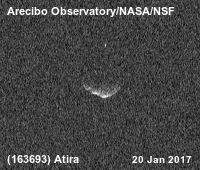 A binary asteroid with two asteroids orbiting their common barycenter. It is one of the largest Near-Earth objects. It is possibly elongated and very angular in shape.
It is the namesake of the Atira asteroids, which have their orbits entirely within that of Earth and are therefore alternatively called Interior-Earth Objects (IEO). As of 2019, there are 36 known members. Atiras are similar to the larger group of Aten asteroids. Contrary to Aten asteroids, however, the aphelion for the Atiras is always smaller than Earth's perihelion, which means that they do not approach Earth as close as Atens do in general.
A binary asteroid with two asteroids orbiting their common barycenter. It is one of the largest Near-Earth objects. It is possibly elongated and very angular in shape.
It is the namesake of the Atira asteroids, which have their orbits entirely within that of Earth and are therefore alternatively called Interior-Earth Objects (IEO). As of 2019, there are 36 known members. Atiras are similar to the larger group of Aten asteroids. Contrary to Aten asteroids, however, the aphelion for the Atiras is always smaller than Earth's perihelion, which means that they do not approach Earth as close as Atens do in general.
▲ Top ▶ Locations Index
A dynamical group of asteroids whose orbits bring them into proximity with Earth. Aten asteroids are defined by having a semi-major axis of less than 1.0 AU. They also have an aphelion greater than 0.983 AU. This defines them as Earth-crossing asteroids as the orbit of Earth varies between 0.983 and 1.017 AU.
Aten asteroids account for only about 7.4% of the known near-Earth asteroid population. Many more Apollo-class asteroids are known than Aten-class asteroids, possibly because of the sampling bias due to observation of objects inferior to the Earth's orbit being difficult.
As of 2020, 1841 Atens have been discovered, of which 13 are named. Many Atens are classified as potentially hazardous asteroids.
Orbit: Squannit
Size: approx. 360 m
Orbital period: 16 hours at approx. 2.6 km.
Type: S-type asteroid
Size: 1.532 x1.495 x1.347 km
Rotation: 2.765 hours
Orbital period: 188 days at 0.64 (0.20 to 1.08) AU.
Category: Aten, Mercury-crosser, Venus-crosser, Potentially Hazardous Object
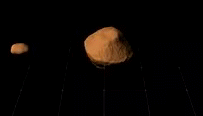 A binary asteroid. The shapes of the two bodies and their dynamics are complex.
The equatorial regions of Moshup are very close to breakup—raising a particle a meter above the surface would put it into orbit around the object. The gravitational effects between the moon and the asteroid create a gigantic mountain extending laterally around the entire asteroid.
A binary asteroid. The shapes of the two bodies and their dynamics are complex.
The equatorial regions of Moshup are very close to breakup—raising a particle a meter above the surface would put it into orbit around the object. The gravitational effects between the moon and the asteroid create a gigantic mountain extending laterally around the entire asteroid.
Type: E-type asteroid
Size: 410 m
Rotation: 3.6970 hours
Orbital period: 222 days at 0.7185 (0.4182 to 1.0187) AU
Category: Aten, Mercury-grazer, Venus-crosser, Earth-crosser, Potentially Hazardous Object
 It is classified as near-Earth object and potentially hazardous asteroid (PHA) of the Aten group, located in Venus's zone of influence, and has frequent close encounters with Mercury, Venus, and Earth.
It has an orbit that not only crosses Earth's orbit, but is roughly parallel to it at its furthest. This means that during favourable years it is easy to reach from Earth, sometimes easier than Earth's own Moon.
It is high on the list of possible Near-Earth Asteroid targets for future flybys, landings, mining, or orbit manipulations.
It is classified as near-Earth object and potentially hazardous asteroid (PHA) of the Aten group, located in Venus's zone of influence, and has frequent close encounters with Mercury, Venus, and Earth.
It has an orbit that not only crosses Earth's orbit, but is roughly parallel to it at its furthest. This means that during favourable years it is easy to reach from Earth, sometimes easier than Earth's own Moon.
It is high on the list of possible Near-Earth Asteroid targets for future flybys, landings, mining, or orbit manipulations.
it's estimated that the surface temperature reaches up to 645°C at perihelion, hot enough to melt lead and zinc, and nearly enough to melt aluminium.
Type: V-type asteroid
Size: 970 m
Rotation: 10.57 hours
Orbital period: 299.7 days at 0.876 (0.092 to 1.660) AU.
Category: Aten, Mercury crosser, Venus crosser, Earth crosser, Mars grazer
A near-Earth object with the smallest perihelion of any numbered asteroid. With its high eccentricity, not only does 2000 BD19 get very close to the Sun, but it also travels relatively far away from it. It has the third largest aphelion of any numbered Aten asteroid, and is one of a small group of Aten asteroids that is also a Mars grazer.
Its orbital elements indicate that may be an extinct comet. It hasn't been seen displaying cometary activity so far.
Studies have described a number of proposals for deflecting Apophis or similar objects, including gravitational tractor, kinetic impact, and nuclear bomb methods.
Type: weathered Sq-type asteroid
Size: 370 (450 x 170) m
Rotation: 30.4 hours
Orbital period: 0.89 years at 0.922 (0.746 to 1.099) AU.
Category: Aten, Near Earth Object, Potentially Object
Apophis caused a brief period of concern in December 2004 when initial observations indicated a probability up to 2.7% that it would hit Earth on April 13, 2029. Additional observations provided improved predictions that eliminated the possibility of an impact on Earth in 2029. During the short time when it had been of greatest concern, Apophis set the record for highest rating ever on the Torino scale, reaching level 4 on December 27, 2004.
 Based on Goldstone and Arecibo radar images, Apophis is an elongated object and is bilobed (possibly a contact binary) with a relatively bright surface albedo. It is a retrograde rotator.
Based on Goldstone and Arecibo radar images, Apophis is an elongated object and is bilobed (possibly a contact binary) with a relatively bright surface albedo. It is a retrograde rotator.
Orbit: 5381 Sekhmet 1
Size: 300 m
Rotation: under investigation
Orbital period: unknown duration at approx. 1.5 km.
Type: S-type asteroid
Size: 1.42 km
Rotation: 2.823 hours
Orbital period: 0.92 years at 0.947 (0.666 to 1.228) AU
Category: Aten, Near Earth Object
An Aten whose orbit is sometimes closer to the Sun than the Earth's.
The asteroid may have a moon, however it is not yet confirmed.
namesake of the Aten asteroids.
Type: S-type asteroid
Size: 910 m
Rotation: 40.77 hours
Orbital period: 0.95 years at 0.966 (0.790 to 1.143) AU
Category: Aten, Earth crosser
It has a longer-than average rotation period of 44.77 hours, and approaches the orbit Earth to 44.1 lunar distances.
▲ Top ▶ Locations Index
Type: rocky planet
Size: 12,742 km
Rotation: 23h 56m 4.10s
Orbital period: 365.256 days at 1.000 (0.983 to 1.0167) AU
Orbit:
1 moon
5 quasi-satellites
Real World Info (as of Sept. 2021):
>4,550 operational satellites
>16,000 space debris
Real World Info (as of 2019 summer):
>1,800 operational satellites
>16,000 space debris
 The densest planet in the Solar System, and the largest of the four terrestrial planets. Earth formed approximately 4.54 billion years ago, and life appeared on its surface within one billion years. Earth's biosphere then significantly altered the atmospheric and other basic physical conditions, which enabled the proliferation of organisms as well as the formation of the ozone layer, which—together with Earth's magnetic field—blocked harmful solar radiation, and permitted formerly ocean-confined life to move safely to land. The physical properties of the Earth, as well as its geological history and orbit, have allowed life to persist.
Earth's crust is divided into several rigid segments, or tectonic plates, that migrate across the surface over periods of many millions of years. The planet's interior remains active, with a solid iron inner core, a liquid outer core that generates the magnetic field, and a thick layer of relatively solid mantle.
The densest planet in the Solar System, and the largest of the four terrestrial planets. Earth formed approximately 4.54 billion years ago, and life appeared on its surface within one billion years. Earth's biosphere then significantly altered the atmospheric and other basic physical conditions, which enabled the proliferation of organisms as well as the formation of the ozone layer, which—together with Earth's magnetic field—blocked harmful solar radiation, and permitted formerly ocean-confined life to move safely to land. The physical properties of the Earth, as well as its geological history and orbit, have allowed life to persist.
Earth's crust is divided into several rigid segments, or tectonic plates, that migrate across the surface over periods of many millions of years. The planet's interior remains active, with a solid iron inner core, a liquid outer core that generates the magnetic field, and a thick layer of relatively solid mantle.
 About 71% of the surface is covered by salt water oceans, with the remainder consisting of continents and islands which together have many lakes and other sources of water that contribute to the hydrosphere. Earth's poles are mostly covered with ice, which is the solid ice of the Antarctic ice sheet and the sea ice that is the polar ice packs.
About 71% of the surface is covered by salt water oceans, with the remainder consisting of continents and islands which together have many lakes and other sources of water that contribute to the hydrosphere. Earth's poles are mostly covered with ice, which is the solid ice of the Antarctic ice sheet and the sea ice that is the polar ice packs.
 Three-quarters of the Earth's atmosphere's mass is contained within the first 11 km of the planet's surface. This lowest layer is called the troposphere. Energy from the Sun heats this layer, and the surface below, causing expansion of the air. This lower density air then rises, and is replaced by cooler, higher density air. The result is atmospheric circulation that drives the weather and climate through redistribution of heat energy. The primary atmospheric circulation bands consist of the trade winds in the equatorial region below 30° latitude and the westerlies in the mid-latitudes between 30° and 60°. Ocean currents are also important factors in determining climate, particularly the thermohaline circulation that distributes heat energy from the equatorial oceans to the polar regions.
Above the troposphere, the atmosphere is usually divided into the stratosphere, mesosphere, and thermosphere. Beyond these, the exosphere thins out into the magnetosphere, where the Earth's magnetic fields interact with the solar wind. Within the stratosphere is the ozone layer, a component that partially shields the surface from ultraviolet light and thus is important for life on Earth.
Earth interacts with other objects in space, especially the Sun and the Moon. The Earth's axis of rotation is tilted 23.4° away from the perpendicular of its orbital plane, producing seasonal variations on the planet's surface with a period of one tropical year. The Moon's gravitational interaction with Earth stimulates ocean tides, stabilizes the axial tilt, and gradually slows the planet's rotation.
Three-quarters of the Earth's atmosphere's mass is contained within the first 11 km of the planet's surface. This lowest layer is called the troposphere. Energy from the Sun heats this layer, and the surface below, causing expansion of the air. This lower density air then rises, and is replaced by cooler, higher density air. The result is atmospheric circulation that drives the weather and climate through redistribution of heat energy. The primary atmospheric circulation bands consist of the trade winds in the equatorial region below 30° latitude and the westerlies in the mid-latitudes between 30° and 60°. Ocean currents are also important factors in determining climate, particularly the thermohaline circulation that distributes heat energy from the equatorial oceans to the polar regions.
Above the troposphere, the atmosphere is usually divided into the stratosphere, mesosphere, and thermosphere. Beyond these, the exosphere thins out into the magnetosphere, where the Earth's magnetic fields interact with the solar wind. Within the stratosphere is the ozone layer, a component that partially shields the surface from ultraviolet light and thus is important for life on Earth.
Earth interacts with other objects in space, especially the Sun and the Moon. The Earth's axis of rotation is tilted 23.4° away from the perpendicular of its orbital plane, producing seasonal variations on the planet's surface with a period of one tropical year. The Moon's gravitational interaction with Earth stimulates ocean tides, stabilizes the axial tilt, and gradually slows the planet's rotation.
Settlements
Civilian Gov.:
Pop.: under investigation
Local Gov.: Unified Government
Main Leader(s): under investigation
Military:
Starport: good quality starport
Top military leader: under investigation
Ship deployed in emergencies: under investigation
Eurasia:
-
Central Russia Administrative Region
- St. Petersburg: the Anti-Unification Alliance destroys the city using tactical thermonuclear reaction weaponry in Oct. 2006.
Danube Area
Japan
Kazakh Autonomous Region:
- location of rioting in Jan. 2005.
Kirghiz Autonomous Region:
- location of rioting in Jan. 2005.
Middle East
- People's Republic of Garalia: outbreak of a dispute in Jul. 2000.
Oceania:
-
Australian Autonomous Region:
- Grand Cannon II: construction begins in Mar. 2004. The under-construction Cannon is destroyed in Nov. 2005, during an Anti-Unification Alliance retaliatory attack on the Unified Forces.
South Pacific Ocean:
- Mayan Island (Macross Compendium): site of Protoculture phenomenon and a dispute over the discovery of it, which resulted in the secret deployment of the VF-0 and SV-51 by the Unified Forces and Anti Unification Alliance Forces in Sep. 2008 (the events are kept secret for at least five decades.)
Guam:
- New Anderson Base: VFF stationed at the base in 2044.
Africa:
-
Victoria Autonomous Region
- Grand Cannon III: construction begins in Oct. 2004.
South America:
-
Brazilian Autonomous Region:
- Grand Cannon V : construction begins in 2007.05
Antarctica:
-
Under investigation
Location unspecificed (may not be on Earth):
-
- Eagle Nest Aerial Tactics Centre: Captain Milia Jenius is an instructor here in 2029.
- New Miramar Base
North America:
-
Alaska
- Grand Cannon I: construction begins in May. 2002, with completion on 2010.01.10 (on the same site as Unified Forces Headquarters)
- Macross City (Macross Compendium): reconstruction begins and is completed in May. 2010. Located east of the former Grand Cannon I site. By far the largest and best city in the Unified Government. Macross city is home to the Macross, and is the capital city of the Unified Government.
- Macross Lake
- SDF-1 Macross
- (Earth) Unified Forces Headquarters: construction for anti-stellar-warfare begins in May. 2002.
Ontario Autonomous Region:
- destroyed by the bursting of Macross's omni-directional barrier on Dec. 6–7, 2009.
Located generally near Macross City:
- Gante City: the city where humans and Zentraadi struggled in, soon after the First Interstellar War.
- Highlander City: located a few hours from Macross City (by air). This city was thriving just after the First Interstellar War and attrached a lot of show business types.
- Ionesco City: Kamjin takes Minmay hostage here in Nov. 2011.
- Onogi City: a major industrial city located not far from Macross City. It is on a coast and is possibly located East of Macross City.
- South Coast City: a city most likely located on a southern coast line. In 2012, the city left direct Unified Government control to be self-governed.
- Trad City: located in old America and has a large Zentraadi presence: 50% population is Zentrādi.
▲ Top ▶ Locations Index
100 km above sea level
 The Kármán Line commonly represents the boundary between the Earth's atmosphere and outer space.
Around this altitude, the atmosphere becomes too thin to support aeronautical flight. There is an abrupt increase in atmospheric temperature and interaction with solar radiation just below the line, which places the line within the greater thermosphere.
Above altitudes of approximately 160 km the sky is completely black.
The Kármán Line commonly represents the boundary between the Earth's atmosphere and outer space.
Around this altitude, the atmosphere becomes too thin to support aeronautical flight. There is an abrupt increase in atmospheric temperature and interaction with solar radiation just below the line, which places the line within the greater thermosphere.
Above altitudes of approximately 160 km the sky is completely black.
Exia Lauder [Axia Roader] Satellite City: Rex born here on Sep. 3, 2026.
Earth Defense Force: Isamu Alva Dyson assigned here from Jan. 23, 2037.
20 Factory Satellites: the first is in orbit from Nov. 2011.

 A Van Allen radiation belt is a zone of energetic charged particles, most of which originate from the solar wind, that are captured by and held around a planet by that planet's magnetic field. Earth has two such belts and sometimes others may be temporarily created. Most of the particles that form the belts are thought to come from solar wind and other particles by cosmic rays. By trapping the solar wind, the magnetic field deflects those energetic particles and protects the atmosphere from destruction.
A Van Allen radiation belt is a zone of energetic charged particles, most of which originate from the solar wind, that are captured by and held around a planet by that planet's magnetic field. Earth has two such belts and sometimes others may be temporarily created. Most of the particles that form the belts are thought to come from solar wind and other particles by cosmic rays. By trapping the solar wind, the magnetic field deflects those energetic particles and protects the atmosphere from destruction.
Inner Belt:
1,000–12,000 km from Earth
Outer Belt:
13,000–60,000 km from Earth
The belts are located in the inner region of Earth's magnetosphere. The belts trap energetic electrons and protons. The belts endanger satellites, which must have their sensitive components protected with adequate shielding if they spend significant time near that zone. In certain cases, the inner boundary may decline to roughly 200 km above the Earth's surface. Due to the slight offset of the belts from Earth's geometric center, the inner belt makes its closest approach to the surface at the South Atlantic Anomaly.
 The boundary between the magnetosphere and the solar wind. It is the boundary at which the speed of the stellar wind abruptly drops as a result of its approach to the magnetopausemdash;the boundary between the magnetic field and the solar wind.
The boundary between the magnetosphere and the solar wind. It is the boundary at which the speed of the stellar wind abruptly drops as a result of its approach to the magnetopausemdash;the boundary between the magnetic field and the solar wind.
Location: approx. 90,000 km from Earth
Thickness: approx. 17 km
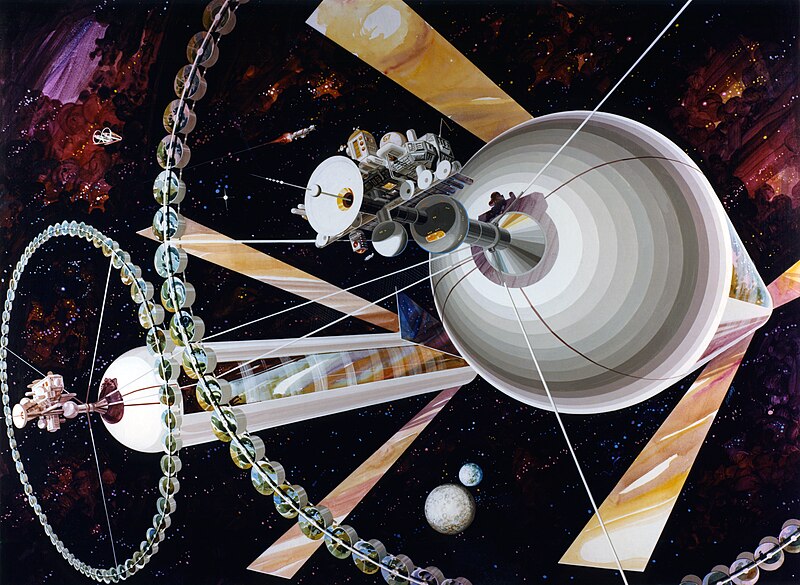 Survived the First Interstellar War unscathed.
The Colony Clusters are likely in a 2:1 resonance orbit that has a close, low-energy (cheap) approach to the moon.
Survived the First Interstellar War unscathed.
The Colony Clusters are likely in a 2:1 resonance orbit that has a close, low-energy (cheap) approach to the moon.
▲ Top ▶ Locations Index
The Lagrangian points are the points near two large bodies in orbit where a smaller object will maintain its position relative to the large orbiting bodies. At other locations, a small object would go into its own orbit around one of the large bodies, but at the Lagrangian points the gravitational forces and so on all match up in a way that cause the small object to maintain a stable, or nearly stable position, relative to the large bodies.
L1
Allows comparatively easy access to Lunar and Earth orbits with minimal change in velocity—this has as an advantage to position a habitable space station intended to help transport cargo and personnel to the Moon and back.
L2
Has been used for a communications satellite covering the Moon's far side, and would be "an ideal location" for a propellant depot as part of the proposed depot-based space transportation architecture.
Large concentrations of dust that exist at the L4 and L5 Lagrangian points of the Earth-Moon system. The Kordylewski clouds are a very faint phenomenon, comparable to the brightness of the gegenschein&mdashi;a faintly bright spot in the night sky, around the antisolar point caused by the backscatter of sunlight by interplanetary dust. The clouds appear somewhat redder than the gegenschein, indicating that they may be made of a different kind of particle.
L4 (leading cloud):
Earth's Lagrange 4 Space Unit: Suzie Newtlet relocates to the unit in 2049 after ending her test pilot assignment.
L5 (trailing cloud):
L-5 Lab Station: location of VF-1 space testing and launch point of Project Trapeze. Destroyed early 2010.
New Frontier: ship Yards and Space Colony (Note: this could be another name for the Manufacturing Station in Lunar Orbit).
▲ Top ▶ Locations Index
Type: rocky satellite
Size: 3,474.8 km (0.2727 Earths)
Rotation: 29.530 days
Orbital period: 27.321 days at 0.00257 AU (362,600 to 405,400 km)
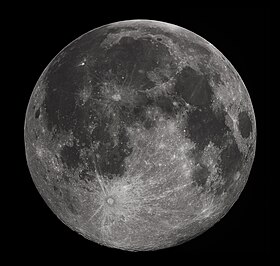 Has a diameter about one-quarter that of Earth. The Moon is a planetary-mass object with a differentiated rocky body, making it a satellite planet. It lacks any significant atmosphere, hydrosphere, or magnetic field. Its surface gravity is about one-sixth of Earth's.
The Moon is tidally locked to Earth. The near side of the Moon is marked by dark volcanic maria ("seas"), which fill the spaces between bright ancient crustal highlands and prominent impact craters. The lunar surface is fairly non-reflective, with the reflectance of lunar soil being comparable to that of asphalt.
The most widely accepted origin explanation posits that the Moon formed 4.51 billion years ago, not long after Earth, out of the debris from a giant impact between the planet and a hypothesized Mars-sized body called Theia. It then receded to a wider orbit because of tidal interaction with the Earth.
Has a diameter about one-quarter that of Earth. The Moon is a planetary-mass object with a differentiated rocky body, making it a satellite planet. It lacks any significant atmosphere, hydrosphere, or magnetic field. Its surface gravity is about one-sixth of Earth's.
The Moon is tidally locked to Earth. The near side of the Moon is marked by dark volcanic maria ("seas"), which fill the spaces between bright ancient crustal highlands and prominent impact craters. The lunar surface is fairly non-reflective, with the reflectance of lunar soil being comparable to that of asphalt.
The most widely accepted origin explanation posits that the Moon formed 4.51 billion years ago, not long after Earth, out of the debris from a giant impact between the planet and a hypothesized Mars-sized body called Theia. It then receded to a wider orbit because of tidal interaction with the Earth.
Settlements
Sea of Tranquility
- Apollo Base Colony: construction of the large-scale permanent base begins in Oct. 2000. Construction begins on the SDF-2—a stellar space warship entirely of Earth origin—in Nov. 2003 in a factory beneath the base, using feedback from restoration work on the ASS-1. Super Valkyries based here start patrols of the Solar System in Jun. 2010.
North Polar Region
- Grand Cannon IV: construction begins in Mar. 2006.
Location unspecified:
- Moon Base: Isamu Alva Dyson assigned here Oct. 30, 2036.
- Moon Riverside City: Lunar surface civilian sector/residential area.
- North Château Residential Area
- Test site of the first thermonuclear reaction bomb detonation: shot in Feb. 2004.
Orbit
- Manufacturing Station: large-scale station and construction site of ARMD Space Combat Carriers and Oberth Space Destroyers from Apr. 2003. Construction begins in May. 2001.
▲ Top ▶ Locations Index

A quasi-satellite is an object in a specific type of co-orbital configuration (1:1 orbital resonance) with a planet where the object stays close to that planet over many orbital periods. A quasi-satellite's orbit around the Sun takes exactly the same time as the planet's, but has a different eccentricity (usually greater), as shown in the diagram on the left. When viewed from the perspective of the planet, the quasi-satellite will appear to travel in an oblong retrograde loop around the planet.
In contrast to true satellites, quasi-satellite orbits lie outside the planet's Hill sphere, and are unstable.
Other types of orbit in a 1:1 resonance with the planet include horseshoe orbits and tadpole orbits around the Lagrangian points, but objects in these orbits do not stay near the planet's longitude over many revolutions about the star. Objects in horseshoe orbits are known to sometimes periodically transfer to a relatively short-lived quasi-satellite orbit, and are sometimes confused with them.
By 2016, orbital calculations showed that all five of Earth's then known quasi-satellites repeatedly transfer between horseshoe and quasi-satellite orbits. The time spent in the quasi-satellite phase differs from asteroid to asteroid.
As of 2016, Earth had five known quasi-satellites.
the fourth known Earth quasi-satellite
Type: stony asteroid
Size: 170 m
Rotation: under investigation
Orbital period: 1.00 years at 0.999 (0.538 to 1.459) AU
Category: Aten, NEO, Venus Crosser, Earth Crosser
Its semi-major axis is similar to that of Earth, but it has a relatively high eccentricity and moderate orbital inclination. Gravitational interaction with Earth causes its orbit to change so that its average period is one year (This means it alternates between being an Aten asteroid and being an Apollo asteroid.) It moves in a retrograde kidney-shaped path going from east to west relative to Earth. The center of the "kidney" moves back and forth over a period of years, from being in front of Earth to being behind Earth, but this movement is centered on Earth.
It became a quasi-satellite at least 775 years ago and will stop being that 165 years from now. This quasi-satellite episode will have had a duration of around a thousand years or more, but less than 2,500 years. Before and after this episode it passes in and out of other types of co-orbital orbits, such as being a trojan or a "passing object" (one whose relative longitude to Earth can attain any value, which is not the case for a quasi-satellite or a Trojan).
currently the smallest, closest, and most stable (known) quasi-satellite of Earth.
Type: S-type asteroid
Size: 41 m
Rotation: 0.467 hours
Orbital period: 1.00 years at 1.001 (0.898 to 1.104) AU
Category: Apollo, Near Earth Object
A very small, fast rotator. The Earth-like orbit and lunar-like silicates may be a result of it being lunar ejecta. As it orbits the Sun, Kamo'oalewa appears to circle around Earth as well. Although it is too distant to be considered a true natural satellite of Earth, it is the best and most stable example to date of a near-Earth companion, or quasi-satellite.
In its yearly trek around the Sun, Kamo'oalewa spends approximately half of the time closer to the Sun than Earth is (inside Earth's orbit) and passes ahead of our planet, and approximately half of the time farther away (outside Earth's orbit), causing it to fall behind. Also, its orbit is tilted a little, causing it to bob up and then down once each year through Earth's orbital plane. However, it never wanders farther away than about 100 times the distance of the moon, or closer than about 38 times the distance of the Moon.
has a low transfer energy from Earth (a low delta-v requirement for rendezvous).
Type: under investigation
Size: 140–320 m
Rotation: under investigation
Orbital period: 1.00 years at 1.00 (0.623 to 1.137) AU
Category: Apollo, Near Earth Object
Although its orbital period is almost exactly 1 year, the orbit of 2006 FV35 has a high eccentricity, which causes it to cross the paths of both Venus and Mars.
the third known Earth quasi-satellite.
Type: under investigation
Size: 130–300 m
Rotation: under investigation
Orbital period: 1.00 years at 1.001 (0.548 to 1.454) AU
Category: Apollo, Venus Crosser, Earth Crosser
A near-Earth object. It has relatively high eccentricity and high orbital inclination. It follows a kidney-shaped retrograde orbit around the Earth.
a potentially hazardous asteroid.
Type: under investigation
Size: 160–360 m
Rotation: under investigation
Orbital period: 1.00 years at 1.00 (0.864 to 1.137) AU
Category: Apollo, Near Earth Object
Will be a quasi-satellite of Earth until around 2,600.
▲ Top ▶ Locations Index
An Earth trojan is an asteroid that orbits the Sun in the vicinity of the Earth-Sun Lagrangian points L4 (leading 60°) and L5 (trailing 60°), thus having an orbit similar to Earth's. Trojans do not orbit right at Lagrangian points, but oscillate in tadpole-shaped loops around them.
The orbits of any Earth trojans could make them less energetically costly to reach than the Moon, even though they will be hundreds of times more distant.
L4 (leading Lagrangian point)
 Type: under investigation
Size: 379±123 m
Rotation: under investigation
Orbital period: 1.00 years at 0.999 (0.809 to 1.190) AU
Category: Earth trojan, Aten
The first Earth trojan discovered; it precedes Earth in its orbit around the Sun. Its path oscillates about the Sun–Earth L4 Lagrangian point (60° ahead of Earth), shuttling between its closest approach to Earth and its closest approach to the L3 point (180° from Earth).
Trojans do not orbit right at Lagrangian points but oscillate in tadpole-shaped loops around them. 2010 TK7 traverses its loop over a period of 395 years. Its loop is so elongated that it sometimes travels nearly to the opposite side of the Sun with respect to Earth. Its movements do not bring it any closer to Earth than 20 million km, more than 50 times the distance to the Moon.
Because Earth trojans share Earth's orbit and have little gravity of their own, less energy might be needed to reach them than the Moon, even though they are much more distant. However, 2010 TK7 is not an energetically attractive target for a space mission because of its orbital inclination—it moves so far above and below Earth's orbit that the required change in velocity for a spacecraft to match its trajectory coming from Earth's would be 9.4 km/s, whereas some other near-Earth asteroids require less than 4 km/s.
Type: under investigation
Size: 379±123 m
Rotation: under investigation
Orbital period: 1.00 years at 0.999 (0.809 to 1.190) AU
Category: Earth trojan, Aten
The first Earth trojan discovered; it precedes Earth in its orbit around the Sun. Its path oscillates about the Sun–Earth L4 Lagrangian point (60° ahead of Earth), shuttling between its closest approach to Earth and its closest approach to the L3 point (180° from Earth).
Trojans do not orbit right at Lagrangian points but oscillate in tadpole-shaped loops around them. 2010 TK7 traverses its loop over a period of 395 years. Its loop is so elongated that it sometimes travels nearly to the opposite side of the Sun with respect to Earth. Its movements do not bring it any closer to Earth than 20 million km, more than 50 times the distance to the Moon.
Because Earth trojans share Earth's orbit and have little gravity of their own, less energy might be needed to reach them than the Moon, even though they are much more distant. However, 2010 TK7 is not an energetically attractive target for a space mission because of its orbital inclination—it moves so far above and below Earth's orbit that the required change in velocity for a spacecraft to match its trajectory coming from Earth's would be 9.4 km/s, whereas some other near-Earth asteroids require less than 4 km/s.
 Type: C-type asteroid
Size: 1.18±0.08 km
Rotation: under investigation
Orbital period: 365.7 days at 1.001 (0.613 to 1.388) AU
Category: Earth Trojan, NEO, Apollo
It is the second Earth trojan discovered, and is the largest of its kind known. 2020 XL5 oscillates around the Sun–Earth L4 Lagrangian point (leading 60°). Analysis of its trojan orbit stability suggests it will remain around Earth's L4 point for at least four thousand years until gravitational perturbations from repeated close encounters with Venus destabilize its trojan configuration.
Since 2020 XL5's orbit crosses the orbits of Venus and Earth. Its high orbital eccentricity results in wide, tadpole-shaped oscillation paths in a corotating reference frame with Earth and its Lagrangian points.
Due to 2020 XL5's high orbital inclination, the minimum total delta-v of a rendezvous mission to the asteroid from low Earth orbit (LEO) is too high to be considered an ideal target for a low-energy trajectory. On the other hand, a flyby trajectory to 2020 XL5 from LEO could be more feasible.
Type: C-type asteroid
Size: 1.18±0.08 km
Rotation: under investigation
Orbital period: 365.7 days at 1.001 (0.613 to 1.388) AU
Category: Earth Trojan, NEO, Apollo
It is the second Earth trojan discovered, and is the largest of its kind known. 2020 XL5 oscillates around the Sun–Earth L4 Lagrangian point (leading 60°). Analysis of its trojan orbit stability suggests it will remain around Earth's L4 point for at least four thousand years until gravitational perturbations from repeated close encounters with Venus destabilize its trojan configuration.
Since 2020 XL5's orbit crosses the orbits of Venus and Earth. Its high orbital eccentricity results in wide, tadpole-shaped oscillation paths in a corotating reference frame with Earth and its Lagrangian points.
Due to 2020 XL5's high orbital inclination, the minimum total delta-v of a rendezvous mission to the asteroid from low Earth orbit (LEO) is too high to be considered an ideal target for a low-energy trajectory. On the other hand, a flyby trajectory to 2020 XL5 from LEO could be more feasible.
L5 (trailing Lagrangian point)
No known objects are currently thought to be L5 trojans of Earth.
▲ Top ▶ Locations Index
A co-orbital is an object, such as asteroids, orbiting at the same—or very similar—distance from the sun (they are in a 1:1 mean-motion resonance).
There are several classes of co-orbital objects, depending on their point of libration. The most common class is the trojan, which librates around one of the two stable Lagrangian points (Trojan points), L4 and L5, 60° ahead of and behind the Earth, respectively. Another class is the horseshoe orbit, in which objects librate around 180° from the Earth. Objects librating around 0° are called quasi-satellites.
Type: Q-type asteroid
Size: approx. 5 km
Rotation: 27.309 hours
Orbital period: 1.00 years at 0.997 (0.484 to 1.511) AU
Category: Aten, Near-Earth Object, Venus-crosser, Mars-crosser
An asteroid that, relative to Earth, orbits the Sun in a bean-shaped orbit that effectively describes a horseshoe, and that can change into a quasi-satellite orbit. Cruithne does not orbit Earth and at times it is on the other side of the Sun. Its orbit takes it inside the orbit of Mercury and outside the orbit of Mars. Cruithne orbits the Sun in about 1 year, but it takes 770 years for the series to complete a horseshoe-shaped movement around the Earth.
Its closest approach to Earth is 0.080 AU, approximately 30 lunar distances. It has probably been synchronized with Earth's orbit for a long time. There is no danger of a collision with Earth for millions of years, if ever. Its orbital path and Earth's do not cross.
because its orbit is very similar to the Earth's, the asteroid is relatively easily reachable by space probes.
Type: S-type asteroid
Size: 20—100 m
Rotation: 0.55 hours
Orbital period: 0.99 years at 0.992 (0.979 to 1.00) AU
Category: Aten, Earth crosser
It revolves about the Sun on an almost circular orbit very similar to that of the Earth. This lies for the most part inside the Earth's orbit, which it crosses near the asteroid's aphelion. It is locked into a 1:1 resonance with the Earth. It follows a so-called horseshoe orbit along the path of the Earth.
The very low orbital eccentricity of 2002 AA29 is also an indication that it must always have been on a near-Earth orbit. Its orbit is slightly tilted compared with that of Earth—if it were not tilted at all, the orbits would lie right on top of each other.
The asteroid rotates so quickly that the centrifugal force on its surface exceeds its gravitational pull. It is therefore under tension and must be made of a single relatively strong block of rock, or of pieces baked together. However, its tensile strength is probably considerably lower than terrestrial rock and the asteroid also very porous.
is estimated to miss Earth by 0.01 AU
Type: under investigation
Size: 10–30 m
Rotation: under investigation
Orbital period: 0.98 years at 0.988 (0.974 to 1.002) AU
Category: Aten, Earth crosser
A micro-asteroid, classified as a near-Earth object of the Aten group moving in a 1:1 mean-motion resonance with Earth. It is estimated to miss Earth by 0.01 AU. It revolves around the Sun on an Earth-like, almost circular, orbit.
From approximately 1997 to 2006, the asteroid remained within 0.1 AU of Earth, and it appeared to slowly orbit Earth. Before 1996, the asteroid had been on a so-called horseshoe orbit around the Sun, along the Earth's orbit. After 2006, it had regained such an orbit.
Type: under investigation
Size: 0.357 km
Rotation: under investigation
Orbital period: 1.00 years at 1.002 ( 0.927 to 1.078) AU
Category: Apollo, Near-Earth Object, Potentially Hazardous Asteroid
2010 SO16 has a horseshoe orbit that allows it to stably share Earth's orbital neighborhood without colliding with it. Its semi-major axis of its orbit is neither less than nor greater than 1 AU, but oscillates between approximately 0.996 and 1.004 AU, with a period of about 350 years. In its 350 yr horseshoe cycle, it never approaches Earth more closely than about 0.15 AU, alternately trailing and leading.
a temporary horseshoe companion to the Earth.
Type: under investigation
Size: 50–111 m
Rotation: under investigation
Orbital period: 1.00 years at 0.998 (0.890 to 1.106 AU
Category: Aten, Earth crosser
It alternates between being an Aten asteroid and being an Apollo asteroid, changing dynamical status approx. every 113 years. As of Nov. 30, 2015, this object is the 14th known Earth co-orbital and the 9th known object following a horseshoe path with respect to our planet. Its orbital evolution characterized by alternating horseshoe and quasi-satellite episodes.
Type: under investigation
Size: 150 x 128 x 93 m
Rotation: 0.20 hours
Orbital period: 1.00 years at 0.998 (0.770 to 1.229 AU
Category: Apollo, NEO
 Measurements of the rotation rate of this object provided the first observational evidence of the YORP effect, hence the name of the asteroid.
Measurements of the rotation rate of this object provided the first observational evidence of the YORP effect, hence the name of the asteroid.
has a nearly a 1:1 resonance with Earth
Type: under investigation
Size: 210–470 m
Rotation: under investigation
Orbital period: 1.00 years at 0.998 (0.653 to 1.342 AU
Category: Aten, NEO
Even though the orbital periods is almost identical with the Earth's, the orbits are very different—1998 UP1 has a highly eccentric orbit and is also very highly inclined.
has a nearly a 1:1 resonance with Earth
Type: under investigation
Size: 7–25 m
Rotation: under investigation
Orbital period: 1.01 years at 1.008 (0.967 to 1.049 AU
Category: Apollo, NEO
With an orbital period of 369.99 days, 2009 BD is in a near 1:1 orbital resonance with Earth, and also has about the same orbit around the Sun as Earth. During the 2011 opposition, 2009 BD approached within 346,000 km of the Earth—less than 1 lunar distance.
▲ Top ▶ Locations Index
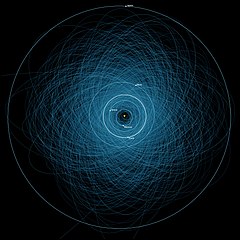
A near-Earth object (NEO) is any small Solar System body whose orbit brings it to proximity with Earth. By convention, a Solar System body is a NEO if its closest approach to the Sun (perihelion) is less than 1.3 AU. If a NEO's orbit crosses the Earth's, and the object is larger than 140 m across, it is considered a potentially hazardous object (PHO). Most known PHOs and NEOs are asteroids, but a small fraction are comets.
There are over 30,503 known near-Earth asteroids (NEAs), over a hundred short-period near-Earth comets (NECs), and a number of solar-orbiting meteoroids large enough to be tracked in space before striking the Earth.
NEOs have low surface gravity, and many have Earth-like orbits making them easy targets for spacecraft. They may present interesting scientific opportunities both for direct geochemical and astronomical investigation, and as potentially economical sources of extraterrestrial materials for human exploitation. This makes them an attractive target for exploration.
 Type: B-type asteroid
Size: 565 x 535 x 508 m
Rotation: 4.296 hours
Orbital period: 1.195 years at 1.126 (0.896 to 1.355) AU
Category: Apollo, NEO, PHO
It has a roughly spheroidal shape, resembling a spinning top. Bennu's axis of rotation is tilted 178° to its orbit; the direction of rotation about its axis is retrograde with respect to its orbit. Bennu's surface is rough with more than 200 boulders larger than 10 m on the surface, the largest of which is 58 m across. There is a well-defined ridge along the equator of Bennu. The presence of this ridge suggests that fine-grained regolith particles have accumulated in this area, possibly because of its low gravity and fast rotation. Bennu is rotating faster over time.
The particles making up Bennu's exterior are loosely packed and lightly bound to each other. Analysis also revealed that the Sun's heat fractures rocks on Bennu in just 10,000 to 100,000 years instead of millions of years as was thought before.
Bennu is an active asteroid, sporadically emitting plumes of particles and rocks as large as 10 cm, (not dust, defined as tens of micrometers). Scientists hypothesize the releases may be caused by thermal fracturing, volatile release through dehydration of phyllosilicates, pockets of subsurface water, and/or meteoroid impacts.
Bennu is a PHO that is listed on the Sentry Risk Table and has the highest cumulative rating on the Palermo Technical Impact Hazard Scale. It has a cumulative 1-in-1,800 chance of impacting Earth between 2178 and 2290.
Type: B-type asteroid
Size: 565 x 535 x 508 m
Rotation: 4.296 hours
Orbital period: 1.195 years at 1.126 (0.896 to 1.355) AU
Category: Apollo, NEO, PHO
It has a roughly spheroidal shape, resembling a spinning top. Bennu's axis of rotation is tilted 178° to its orbit; the direction of rotation about its axis is retrograde with respect to its orbit. Bennu's surface is rough with more than 200 boulders larger than 10 m on the surface, the largest of which is 58 m across. There is a well-defined ridge along the equator of Bennu. The presence of this ridge suggests that fine-grained regolith particles have accumulated in this area, possibly because of its low gravity and fast rotation. Bennu is rotating faster over time.
The particles making up Bennu's exterior are loosely packed and lightly bound to each other. Analysis also revealed that the Sun's heat fractures rocks on Bennu in just 10,000 to 100,000 years instead of millions of years as was thought before.
Bennu is an active asteroid, sporadically emitting plumes of particles and rocks as large as 10 cm, (not dust, defined as tens of micrometers). Scientists hypothesize the releases may be caused by thermal fracturing, volatile release through dehydration of phyllosilicates, pockets of subsurface water, and/or meteoroid impacts.
Bennu is a PHO that is listed on the Sentry Risk Table and has the highest cumulative rating on the Palermo Technical Impact Hazard Scale. It has a cumulative 1-in-1,800 chance of impacting Earth between 2178 and 2290.
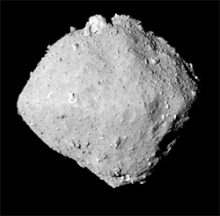 Type: Cg-type asteroid
Size: 1,004 x 876 m
Rotation: 7.632 hours
Orbital period: 1.30 years at 1.189 (0.963 to 1.415) AU
Category: Apollo, NEO, PHO
It is a dark object of the rare spectral type Cb, with qualities of both a C-type asteroid and a B-type asteroid. Ryugu formed as part of an asteroid family, belonging either to Eulalia or Polana. The large number of boulders on the surface supports a catastrophic disruption of the parent body.
Ryugu has a diamond-shaped body and a retrograde rotation. It is a rubble pile with about 50% of its volume being empty space. Ryugu is a spinning top-shape asteroid similar to Bennu. The ridge was shaped by strong centrifugal forces during a phase of high-speed rotation, through landslides and/or internal failure. The western side, also called the western bulge, has a distinct shape. It has a smooth surface with a sharp equatorial ridge.
The surface of Ryugu is porous and contains no or very little dust. Ryugu contains two different almost black types of rock with little internal cohesion, but no dust was detected. One type of rocky material on the surface is brighter with a smooth surface and sharp edges. The other type of rock is dark with a cauliflower-like, crumbly surface. There is a coating of dark, fine-grained red material.
Ryugu contains 4,400 boulders with a size larger than 5 metres. Ryugu has more large boulders per surface area than Itokawa or Bennu, about one boulder larger than 20 m per 50 km2. The high number of boulders is explained with a catastrophic disruption of Ryugu's larger parent body. The largest boulder, called Otohime, has a size of ~160 x 120 x 70 m, and is too large to be explained as an ejected boulder from a crater.
Type: Cg-type asteroid
Size: 1,004 x 876 m
Rotation: 7.632 hours
Orbital period: 1.30 years at 1.189 (0.963 to 1.415) AU
Category: Apollo, NEO, PHO
It is a dark object of the rare spectral type Cb, with qualities of both a C-type asteroid and a B-type asteroid. Ryugu formed as part of an asteroid family, belonging either to Eulalia or Polana. The large number of boulders on the surface supports a catastrophic disruption of the parent body.
Ryugu has a diamond-shaped body and a retrograde rotation. It is a rubble pile with about 50% of its volume being empty space. Ryugu is a spinning top-shape asteroid similar to Bennu. The ridge was shaped by strong centrifugal forces during a phase of high-speed rotation, through landslides and/or internal failure. The western side, also called the western bulge, has a distinct shape. It has a smooth surface with a sharp equatorial ridge.
The surface of Ryugu is porous and contains no or very little dust. Ryugu contains two different almost black types of rock with little internal cohesion, but no dust was detected. One type of rocky material on the surface is brighter with a smooth surface and sharp edges. The other type of rock is dark with a cauliflower-like, crumbly surface. There is a coating of dark, fine-grained red material.
Ryugu contains 4,400 boulders with a size larger than 5 metres. Ryugu has more large boulders per surface area than Itokawa or Bennu, about one boulder larger than 20 m per 50 km2. The high number of boulders is explained with a catastrophic disruption of Ryugu's larger parent body. The largest boulder, called Otohime, has a size of ~160 x 120 x 70 m, and is too large to be explained as an ejected boulder from a crater.
Asclepius makes close orbital passes with Earth.
Type: under investigation
Size: 300 m
Rotation: under investigation
Orbital period: 1.03 years at 1.022 (0.657 to 1.387) AU
Category: Apollo, NEO, PHO
It passed by Earth on Mar. 22 1989, at a distance of 0.00457 AU. Although this exceeds the Moon's orbital radius, the close pass received attention at that time. The asteroid was discovered Mar. 21, 1989, nine days after its closest approach to the Earth. Subsequent discoveries revealed that a whole class of such objects exists. Close approaches by objects the size of Asclepius pass by every two or three years—ndetected until the start of computerized near-Earth object searches.
On Mar. 24 2051, the asteroid will pass 0.0123 AU from the Earth. It will be the eighth pass of less than 30 Gm in this century. The uncertainty region of the asteroid will cause it to mostly likely pass from 0.02 AU to 0.17 AU from the Earth in 2135.
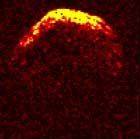 Type: S-type asteroid
Size: 1.39 x 1.46 x 1.07 km
Rotation: 2.121 hours
Orbital period: 2.21 years at 1.698 (0.835 to 2.561) AU
Category: Apollo, NEO, PHO, Mars-crosser
It once had the highest known probability of impacting Earth. As of 2022, It is listed on the Sentry Risk Table with the second highest cumulative Palermo rating of –2.05 (impact risk of 1-in-34,000). 1950 DA is not assigned a Torino scale rating, because the 2880 date is over 100 years in the future.
Due to its short rotation period and high radar albedo, 1950 DA is thought to be fairly dense (assuming that it has no internal strength) and likely composed of nickel–iron.
Type: S-type asteroid
Size: 1.39 x 1.46 x 1.07 km
Rotation: 2.121 hours
Orbital period: 2.21 years at 1.698 (0.835 to 2.561) AU
Category: Apollo, NEO, PHO, Mars-crosser
It once had the highest known probability of impacting Earth. As of 2022, It is listed on the Sentry Risk Table with the second highest cumulative Palermo rating of –2.05 (impact risk of 1-in-34,000). 1950 DA is not assigned a Torino scale rating, because the 2880 date is over 100 years in the future.
Due to its short rotation period and high radar albedo, 1950 DA is thought to be fairly dense (assuming that it has no internal strength) and likely composed of nickel–iron.
On Nov. 8 2011, it passed 0.85 lunar distances from Earth.
Type: C-type asteroid
Size: 360±40 m
Rotation: 19.31 hours
Orbital period: 1.25 years at 1.157 (0.659 to 1.656) AU
 Category: Apollo, NEO, PHO
Shape modeling based on the radar images shows that 2005 YU55's shape is close to spheroidal, and has an equator-aligned ridge. A 150–200-meter-long, ~20-meter-high rise forms a portion of the ridge-line, and the number of boulders on the surface is comparable to that seen on the asteroid 25143 Itokawa.
Category: Apollo, NEO, PHO
Shape modeling based on the radar images shows that 2005 YU55's shape is close to spheroidal, and has an equator-aligned ridge. A 150–200-meter-long, ~20-meter-high rise forms a portion of the ridge-line, and the number of boulders on the surface is comparable to that seen on the asteroid 25143 Itokawa.
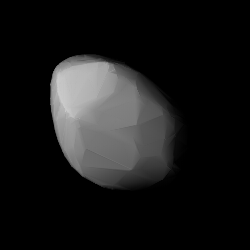 Type: S-type asteroid
Size: 3.810 km
Rotation: 10.185 hours
Orbital period: 1.60 years at 1.367 (0.771 to 1.963) AU
Category: Apollo, NEO, Earth-crosser, Mars-crosser
It is on an eccentric orbit. Toro's orbit also shows a 5:8 resonance with Earth and in a near 5:13 resonance with Venus. This near resonance results from Earth and Venus being in a near 8:13 resonance with each other. The current resonance with Earth will last for only a few thousand years.
Toro's Earth minimum orbit intersection distance of 0.0507 AU, just above the 0.05 AU requirement to be listed as a PHO.
Its rotation period is slowly increasing due to the YORP effect.
Type: S-type asteroid
Size: 3.810 km
Rotation: 10.185 hours
Orbital period: 1.60 years at 1.367 (0.771 to 1.963) AU
Category: Apollo, NEO, Earth-crosser, Mars-crosser
It is on an eccentric orbit. Toro's orbit also shows a 5:8 resonance with Earth and in a near 5:13 resonance with Venus. This near resonance results from Earth and Venus being in a near 8:13 resonance with each other. The current resonance with Earth will last for only a few thousand years.
Toro's Earth minimum orbit intersection distance of 0.0507 AU, just above the 0.05 AU requirement to be listed as a PHO.
Its rotation period is slowly increasing due to the YORP effect.
 Type: X-type asteroid
Size: 30 m
Rotation: 0.178 hours
Orbital period: 1.37 years at 1.232 (0.984 to 1.481) AU
Category: Apollo, NEO
A nearly spherical sub-kilometer asteroid. It is a fast rotator, having a rotational period of only 10.7 minutes; most asteroids have periods measured in hours. As a result, it cannot possibly be a rubble pile, as many asteroids are thought to be, and must instead be a monolithic object.
1998 KY26 has an Earth minimum orbital intersection distance of approximately 0.0025 AU (374,000 km), corresponding to 0.98 lunar distances. As a result, it is one of the most easily accessible objects in the Solar System, and its orbit frequently brings it on a path very similar to the optimum Earth–Mars transfer orbit. This, coupled with its high water content, makes it an attractive target for further study and a potential source of water for future missions to Mars.
Type: X-type asteroid
Size: 30 m
Rotation: 0.178 hours
Orbital period: 1.37 years at 1.232 (0.984 to 1.481) AU
Category: Apollo, NEO
A nearly spherical sub-kilometer asteroid. It is a fast rotator, having a rotational period of only 10.7 minutes; most asteroids have periods measured in hours. As a result, it cannot possibly be a rubble pile, as many asteroids are thought to be, and must instead be a monolithic object.
1998 KY26 has an Earth minimum orbital intersection distance of approximately 0.0025 AU (374,000 km), corresponding to 0.98 lunar distances. As a result, it is one of the most easily accessible objects in the Solar System, and its orbit frequently brings it on a path very similar to the optimum Earth–Mars transfer orbit. This, coupled with its high water content, makes it an attractive target for further study and a potential source of water for future missions to Mars.
▲ Top ▶ Locations Index
The Apollo asteroids are a group of near-Earth asteroids. They are Earth-crossing asteroids that have an orbital semi-major axis greater than that of the Earth (1 AU), but perihelion distances less than the Earth's aphelion distance (1.017 AU).
As of December 2018 the number of known Apollo asteroids is 10,485, of which 1,409 are numbered (asteroids are not numbered until they have been observed at two or more oppositions), and 1,648 are identified as potentially hazardous asteroids.
the first asteroid to be modeled by radar imaging.
 Type: S-type asteroid
Size: 1.4 km
Rotation: 4.095 hours
Orbital period: 1.10 years at 1.063 (0.549 to 1.577) AU
Category: Apollo, NEO, PHO, Venus-crosser, Mars-crosser
It has a peanut shape, suggesting two approximately 800-meter-diameter pieces held together by their weak mutual gravity. Castalia is a potentially hazardous asteroid (PHA) because its minimum orbit intersection distance (MOID) is 0.0204 AU. On Aug. 25, 1989 it passed 4,029,840 km (within eleven lunar distances) of Earth.
Type: S-type asteroid
Size: 1.4 km
Rotation: 4.095 hours
Orbital period: 1.10 years at 1.063 (0.549 to 1.577) AU
Category: Apollo, NEO, PHO, Venus-crosser, Mars-crosser
It has a peanut shape, suggesting two approximately 800-meter-diameter pieces held together by their weak mutual gravity. Castalia is a potentially hazardous asteroid (PHA) because its minimum orbit intersection distance (MOID) is 0.0204 AU. On Aug. 25, 1989 it passed 4,029,840 km (within eleven lunar distances) of Earth.
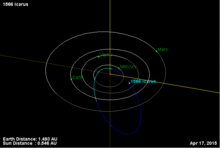 Type: S-type asteroid
Size: 1.61 x 1.60 x 1.17 km
Rotation: 2.268 hours
Orbital period: 1.12 years at 1.078 (0.186 to 1.969) AU
Category: Apollo, NEO, PHO, Mercury-crosser, Venus-crosser, Mars-crosser
The lowest numbered potentially hazardous asteroid. Icarus has is an extremely eccentric orbit. In 1968, it became the first asteroid ever observed by radar.
Icarus's orbit brings it closer to the Sun than Mercury and further out than the orbit of Mars. It is a relatively fast rotator.
Icarus has a MOID of 0.0352 AU (5,270,000 km), or 13.7 lunar distances. It makes close approaches to Earth in June at intervals of 9, 19, or 28 years.
Icarus is being studied to better understand general relativity, solar oblateness, and Yarkovsky drift. In its case, the perihelion precession caused by general relativity is 10.05 arcseconds per Julian century.
Type: S-type asteroid
Size: 1.61 x 1.60 x 1.17 km
Rotation: 2.268 hours
Orbital period: 1.12 years at 1.078 (0.186 to 1.969) AU
Category: Apollo, NEO, PHO, Mercury-crosser, Venus-crosser, Mars-crosser
The lowest numbered potentially hazardous asteroid. Icarus has is an extremely eccentric orbit. In 1968, it became the first asteroid ever observed by radar.
Icarus's orbit brings it closer to the Sun than Mercury and further out than the orbit of Mars. It is a relatively fast rotator.
Icarus has a MOID of 0.0352 AU (5,270,000 km), or 13.7 lunar distances. It makes close approaches to Earth in June at intervals of 9, 19, or 28 years.
Icarus is being studied to better understand general relativity, solar oblateness, and Yarkovsky drift. In its case, the perihelion precession caused by general relativity is 10.05 arcseconds per Julian century.
 Type: S-type asteroid
Size: 5.0 x 2.0 x 2.1 km
Rotation: 5.222 hours
Orbital period: 1.39 years at 1.245 (0.827 to 1.662) AU
Category: Apollo, NEO, PHO, Mars-crosser
A highly elongated, stony asteroid. Geographos has a MOID of 4,500,000 km), which translates into 11.7 lunar distances. The Yarkovsky effect is causing a decrease in its orbital semimajor axis, while the YORP effect is increasing the asteroid's rotation.
The interior of the asteroid probably has a rubble-pile structure. The asteroid's high thermal inertia indicates the surface is most likely a mix of fine grains and large rocks and boulders.
Type: S-type asteroid
Size: 5.0 x 2.0 x 2.1 km
Rotation: 5.222 hours
Orbital period: 1.39 years at 1.245 (0.827 to 1.662) AU
Category: Apollo, NEO, PHO, Mars-crosser
A highly elongated, stony asteroid. Geographos has a MOID of 4,500,000 km), which translates into 11.7 lunar distances. The Yarkovsky effect is causing a decrease in its orbital semimajor axis, while the YORP effect is increasing the asteroid's rotation.
The interior of the asteroid probably has a rubble-pile structure. The asteroid's high thermal inertia indicates the surface is most likely a mix of fine grains and large rocks and boulders.
orbit brings it closer to the Sun than any other named asteroid
Type: F-type asteroid
Size: 5.8 km
Rotation: 3.604 hours
Orbital period: 1.434 years at 1.271 (0.139 to 2.402) AU
Category: Apollo, Potentially Hazardous Asteroid, Mercury crosser, Venus crosser, Mars crosser
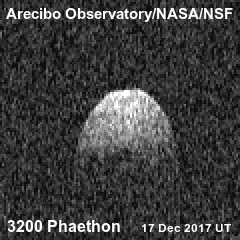 An Apollo asteroid whose perihelion is only 0.14 AU, less than half of Mercury's perihelial distance. The surface temperature at perihelion could reach around 750°C.
It is the parent body of the Geminids meteor shower of mid-December. It is also suspected to be a member of the Pallas family of asteroids.
An Apollo asteroid whose perihelion is only 0.14 AU, less than half of Mercury's perihelial distance. The surface temperature at perihelion could reach around 750°C.
It is the parent body of the Geminids meteor shower of mid-December. It is also suspected to be a member of the Pallas family of asteroids.
 Type: S-type asteroid
Size: 535 x 294 x 209 m
Rotation: 12.132 hours
Orbital period: 1.52 years at 1.324 (0.953 to 1.695) AU
Category: Apollo, NEO, PHO, Mars crosser
The peanut-shaped asteroid is considered to be a rubble pile—consisting of numerous boulders of different sizes rather than of a single solid body—due to its low density and high porosity, Itokawa
Itokawa may be a contact binary formed by two or more smaller asteroids that have gravitated toward each other and stuck together. There is a surprising lack of impact craters and a very rough surface studded with boulders, described by the mission team as a rubble pile. Furthermore, the density of the asteroid is too low for it to be made from solid rock.
Itokawa was probably made up from interior fragments of a larger asteroid that broke apart. Itokawa had been a "water-rich asteroid".
Type: S-type asteroid
Size: 535 x 294 x 209 m
Rotation: 12.132 hours
Orbital period: 1.52 years at 1.324 (0.953 to 1.695) AU
Category: Apollo, NEO, PHO, Mars crosser
The peanut-shaped asteroid is considered to be a rubble pile—consisting of numerous boulders of different sizes rather than of a single solid body—due to its low density and high porosity, Itokawa
Itokawa may be a contact binary formed by two or more smaller asteroids that have gravitated toward each other and stuck together. There is a surprising lack of impact craters and a very rough surface studded with boulders, described by the mission team as a rubble pile. Furthermore, the density of the asteroid is too low for it to be made from solid rock.
Itokawa was probably made up from interior fragments of a larger asteroid that broke apart. Itokawa had been a "water-rich asteroid".
Orbit: S/2005 (1862) 1
Size: 80 m
Rotation: under investigation
Orbital period: at 3 km
Type: Q-type asteroid
Size: 1.5 km
Rotation: 3.065 hours
Orbital period: 1.78 years at 1.470 (0.646 to 2.293) AU
Category: Apollo, NEO, PHO, Venus-crosser, Mars-crosser
 It is the namesake and the first recognized member of the Apollo asteroids, a subgroup of NEOs which are Earth-crossers.
1862 Apollo's MOID 0.0257 AU (3,840,000 km.
It is the namesake and the first recognized member of the Apollo asteroids, a subgroup of NEOs which are Earth-crossers.
1862 Apollo's MOID 0.0257 AU (3,840,000 km.
one of the largest known Earth-Crossing Asteroids.
Type: under investigation
Size: 2.8 km
Rotation: 14.218 hours
Orbital period: 2.06 years at 1.621 (0.555 to 2.687) AU
Category: Apollo, Near Earth Object, Potentially Hazardous Asteroid, Venus-crosser, Earth-crosser, Mars-crosser
 It has a MOID of 0.0263 AU, which is close enough to classify it as a potentially hazardous asteroid (PHA). The Earth MOID of 1990 MU has been decreasing (becoming more hazardous) during the 20th century, while the Venus MOID (0.0455) has been increasing.
It has a MOID of 0.0263 AU, which is close enough to classify it as a potentially hazardous asteroid (PHA). The Earth MOID of 1990 MU has been decreasing (becoming more hazardous) during the 20th century, while the Venus MOID (0.0455) has been increasing.
Orbit: Beta
Size: ~6 billion kg
Orbital period 1: 1.243 days at 1.7 km
Gamma
Size: ~1 billion kg
Orbital period 1: 8.376 days at 6.1 km
Type: S-type asteroid
Size: 620±60 m
Rotation: 2.388 hours
Orbital period: 2.10 years at 1.637 (0.955 to 2.320) AU
Category: Apollo, NEO, PHO, Earth-crosser
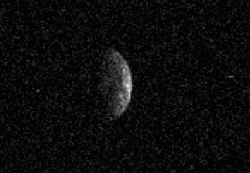 It is a triple system—the largest body is orbited by two satellites—only about 1% of near-Earth asteroids observed by a radar are found to be triple systems such as this one. 1994 CC is only the second triple system known in the near-Earth objects population.
Preliminary analysis of the system suggests that the moons are at least 50 meters in diameter.
1
It is a triple system—the largest body is orbited by two satellites—only about 1% of near-Earth asteroids observed by a radar are found to be triple systems such as this one. 1994 CC is only the second triple system known in the near-Earth objects population.
Preliminary analysis of the system suggests that the moons are at least 50 meters in diameter.
1 Rotation period unknown
Orbit: natural satellite
Size: unknown
Rotation: unknown
Orbital period: 27.16 hours at unknown distance
Type: S-type asteroid
Size: 5.7—8.9 km
Rotation: 2.4 hours
Orbital period: 2.61 years at 1.893 (0.874 to 2.913) AU
Category: Apollo, NEO, Mar-crosser
A binary asteroid, and the largest member of the Apollo group. Sisyphus has a MOID of 0.1037 AU (15,500,000 km), which corresponds to 40.4 lunar distances.
It is the largest of the Earth-crossing asteroids, comparable in size to the Chicxulub object whose impact contributed to the extinction of the dinosaurs.
Type: S-type asteroid
Size: 1.849±0.022 km
Rotation: 67.5±0.6 hours
Orbital period: 3.26 years at 2.200 (0.741 to 3.658) AU
Category: Apollo, NEO, PHO
An eccentric asteroid and suspected contact-binary, which is composed of two distinct lobes in mutual contact, held together by their weak gravitational attraction. They typically show a bifurcated, dumbbell-like shape. A large number of near-Earth objects are believed to be contact-binaries.. It is a relatively slow rotator.
As a PHO, it has a low minimum orbit intersection distance with Earth of 0.0462 AU (6,910,000 km), 18.0 lunar distances.
▲ Top ▶ Locations Index

the semi-major axis is greater than 1.0 AU
the orbit does not cross that of Earth
it is a NEO (perihelion less than 1.3 AU)
A group of near-Earth asteroids with a perihelion close to, but greater than, the orbital aphelion of Earth (the objects do not cross Earth's orbit). Most Amors cross the orbit of Mars.
As of 2019 there are 7,427 known Amor asteroids. 1,153 are numbered, and 75 of them are named.
Outer Earth-grazer asteroids
An asteroid that can get closer to the Sun than Earth's aphelion (1.0167 AU), and not closer than Earth's perihelion (0.9833 AU)—the asteroid's perihelion is between Earth's perihelion and aphelion. Outer Earth-grazer asteroids are split between Amor and Apollo asteroids.
"Earth grazers" that never get closer to the Sun than the Earth does (at any point along its orbit) are Amors, whereas those that do are Apollos.
Potentially Hazardous Object
The object's orbit must come within 0.05 AU of Earth's orbit, and the object itself must be sufficiently large/massive to cause significant regional damage if it impacted Earth. Most PHOs are either Aten or Apollo asteroids (and thus have orbits that cross the orbit of Earth), but approximately one tenth of PHOs are Amor asteroids. A potentially hazardous Amor asteroid therefore must have a perihelion of less than 1.05 AU. Approximately 20% of the known Amors meet this requirement, and 50 of those (about a fifth) are PHOs.
Orbit: Dimorphos
Size: 208 x 160 x 133 m
Rotation: 11.23 hours (synchronous)
Orbital period: 11.23 hours at a distance of 1.19±0.03 km
Type: S-type asteroid
Size: 832 x 838 x 786 m
Rotation: 2.26 hours
Orbital period: 2.11 years at 1.644 (1.013 to 2.275) AU
Category: Amor, NEO, PHO, Mars-crosser
 A sub-kilometer asteroid and binary asteroid. It rotates rapidly and has a nearly spheroidal shape. Didymos's MOID is currently 0.04 AU (6.0 million km), but will change as the asteroid is perturbed.
Didymos is a binary asteroid with a satellite in its orbit. The moon, named Dimorphos, moves in a mostly circular retrograde orbit. It has been characterised as a low-density rubble pile. Dimorphos was the target of the DART mission to test the viability of asteroid impact avoidance by collision with a spacecraft.
A sub-kilometer asteroid and binary asteroid. It rotates rapidly and has a nearly spheroidal shape. Didymos's MOID is currently 0.04 AU (6.0 million km), but will change as the asteroid is perturbed.
Didymos is a binary asteroid with a satellite in its orbit. The moon, named Dimorphos, moves in a mostly circular retrograde orbit. It has been characterised as a low-density rubble pile. Dimorphos was the target of the DART mission to test the viability of asteroid impact avoidance by collision with a spacecraft.
Orbit: Inner Moon
Size: 180–240 m
Rotation: 7 hours (synchronous)
Orbital period: 7 hours at unknown distance
Outer Moon
Size: 300–360 m
Rotation: 21–23 hours (synchronous)
Orbital period: 21–23 hours at unknown distance
Type: S-type asteroid
Size: 4.010±1.237 km
Rotation: 2.358 hours
Orbital period: 2.35 years at 1.769 (1.020 to 2.518) AU
Category: Amor, NEO, PHO
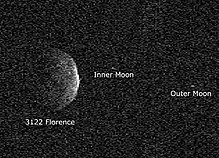 A stony asteroid with two moons. Florence's MOID on Sept. 1, 2017 was 0.047237 AU (7,066,600 km), or eighteen times the average distance of the Moon.
Each moon is somewhat elongated, and both are tidally locked to the main body. They probably formed as loose material spun away from the main body as its rotation accelerated due to the YORP effect. The inner moon of Florence has the shortest orbital period of any of the moons of the 60 near-Earth asteroids known to have moons.
A stony asteroid with two moons. Florence's MOID on Sept. 1, 2017 was 0.047237 AU (7,066,600 km), or eighteen times the average distance of the Moon.
Each moon is somewhat elongated, and both are tidally locked to the main body. They probably formed as loose material spun away from the main body as its rotation accelerated due to the YORP effect. The inner moon of Florence has the shortest orbital period of any of the moons of the 60 near-Earth asteroids known to have moons.
namesake of the Amor asteroids.
Type: S-type asteroid
Size: 0.857 km
Rotation: under investigation
Orbital period: 2.66 years at 1.919 (1.083 to 2.755) AU
Category: Amor, NEO, Mars-crosser
It is on an eccentric orbit. Amor's MOID is 0.1069 AU (16,000,000 km) which corresponds to 41.6 lunar distances.
As of 2018, no rotational lightcurve of Amor has been obtained from photometric observations. The body's rotation period, pole and shape remain unknown.
 Type: V-type asteroid
Size: 0.5 km
Rotation: 4.426 hours
Orbital period: 2.68 years at 1.927 (1.042 to 2.811) AU
Category: Amor, Mars-crosser
It may be a fragment of the asteroid 4 Vesta. The asteroid can best be described as spherical but with many protruding lumps.
Type: V-type asteroid
Size: 0.5 km
Rotation: 4.426 hours
Orbital period: 2.68 years at 1.927 (1.042 to 2.811) AU
Category: Amor, Mars-crosser
It may be a fragment of the asteroid 4 Vesta. The asteroid can best be described as spherical but with many protruding lumps.
Orbit: Gamma
Size: 430±140 m
Rotation: unknown
Orbital period: 16.464 hours at 3.8 km
Beta
Size: 770±120 m
Rotation: unknown
Orbital period: 6.225 days at 16.6 km
"Alpha"
Type: C-type asteroid
Size: 2.5 km
Rotation: 3.423 hours
Orbital period: 2.80 years at 1.986 (1.036 to 2.936) AU
Category: Amor, NEO
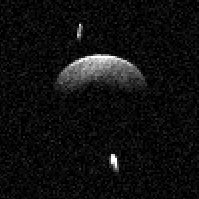 A carbonaceous trinary asteroid. The largest body ("Alpha") is spheroid in shape. The satellites, named Beta and Gamma, are several times smaller in size.
It has a MOID of 0.0520 AU (7,780,000 km), which translates into 20.3 lunar distances. With an Earth MOID above 0.05 AU, 2001 SN263 is no longer a PHO, but it was classified as such until early 2017.
The orbital planes of both satellites are inclined relative to each other. Such a large inclination is suggestive of past evolutionary events (e.g. close encounter with a terrestrial planet, mean-motion-resonance crossing) that may have excited their orbits from a coplanar configuration to an inclined state.
A carbonaceous trinary asteroid. The largest body ("Alpha") is spheroid in shape. The satellites, named Beta and Gamma, are several times smaller in size.
It has a MOID of 0.0520 AU (7,780,000 km), which translates into 20.3 lunar distances. With an Earth MOID above 0.05 AU, 2001 SN263 is no longer a PHO, but it was classified as such until early 2017.
The orbital planes of both satellites are inclined relative to each other. Such a large inclination is suggestive of past evolutionary events (e.g. close encounter with a terrestrial planet, mean-motion-resonance crossing) that may have excited their orbits from a coplanar configuration to an inclined state.
Orbit: S/1997 (3671) 1
Size: 300 m
Rotation: under investigation
Orbital period: 27.72 hours at 3.6 km.
Type: B-type asteroid
Size: 1.5 km
Rotation: 2.705 hours
Orbital period: 3.26 years at 2.198 (1.008 to 3.389) AU
Category: Amor, PHO, Mars-crosser
A small binary asteroid orbiting between Earth and the asteroid belt. It is an outer Earth grazer because its perihelion is just within Earth's orbit. 3671 Dionysus's MOID is 0.01989 AU (2,976,000 km).
Type: S-type asteroid
Size: 2.36 km
Rotation: 5.801 hours
Orbital period: 4.29 years at 2.639 (1.196 to 4.083) AU
Category: Amor, NEO, Mars-crosser
It has a MOID of 0.2030 AU (30,400,000 km), which translates into 79.1 lunar distances.
Albert was the second Amor asteroid discovered, the first being 433 Eros.
▲ Top ▶ Locations Index
Type: S-type asteroid
Size: 16.84±0.06 km
Rotation: 5.270 hours
Orbital period: 1.76 years at 1.457 (1.133 to 1.782) AU
Category: Amor, NEO, Mars-crosser
Civilian Gov.:
Pop.: hundreds
Local Gov.: Unified Government
Main Leader(s): under investigation
Top military leader: under investigation
Military:
Starport: small, basic
Ship deployed in emergencies: none
Settlements:
Charlois Regio (Capital), less than 300 residents
Witt Regio (2nd largest), less than 100 residents
Towns & Villages: none
mining and Unified Forces outpost
most settlements are underground to protect against solar wind, etc.
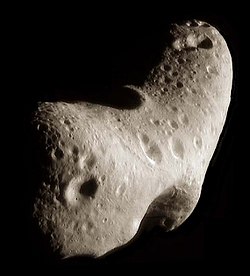 The first discovered and second-largest near-Earth object with an elongated shape and a mean diameter of approximately 16.8 km. Visited by the NEAR Shoemaker space probe in 1998, it became one of the first asteroids visited by a spacecraft, the first one orbited, and the first one soft-landed on.
Most of the larger rocks strewn across Eros were ejected from a single crater—Charlois Regio—in an impact approximately 1 billion years ago. This event may also be responsible for the 40% of the Erotian surface that is devoid of craters smaller than 0.5 km across.
Data suggests that it could contain 20 billion tonnes of aluminum and similar amounts of metals that are rare on Earth, such as gold and platinum.
The first discovered and second-largest near-Earth object with an elongated shape and a mean diameter of approximately 16.8 km. Visited by the NEAR Shoemaker space probe in 1998, it became one of the first asteroids visited by a spacecraft, the first one orbited, and the first one soft-landed on.
Most of the larger rocks strewn across Eros were ejected from a single crater—Charlois Regio—in an impact approximately 1 billion years ago. This event may also be responsible for the 40% of the Erotian surface that is devoid of craters smaller than 0.5 km across.
Data suggests that it could contain 20 billion tonnes of aluminum and similar amounts of metals that are rare on Earth, such as gold and platinum.
Settlements were established on Eros shortly after the First Interstellar War. Mining and observation facilities were concurrently established, and a contingent of Variable Fighters were deployed to Eros.
The settlements reached their peak in the early 20's. Mining activities began to decline as more and more exo-solar areas were settled and developed in the Humankind Dissemination Plan. The Variable Fighters left in the late 30's with the deployment of the External Fold Booster, and the observation facilities were cut back with the introduction of Fold Wave Sensors in the 2050's.
By the 2070's, the Unified Government presence is limited to a listening post/inner solar system surveillance facilities, and a handful of small mining settlements. The Unified Government facilities are centred on Witt Regio, and the mining and refining industries are centred on the larger Charlois Regio—also the location of the "main" starport—.
While the Unified Forces personnel assigned to Eros find it extremely remote and boring, the civilian miners love the quiet and laid-back atmosphere that comes from being off the beaten track. The settlements are not self-sufficient, and rely on a steady flow of water, food, and other resources from the outside.
Orbit
no natural satellites
automated surveillance systems and beacons only
A Northampton class Stealth Frigate makes semi-regular check-ups on Eros and other small settlements within the orbit of Mars. A bulk cargo transport ship visits on a regular schedule—to deliver supplies and pick-up minerals.
▲ Top ▶ Locations Index
Type: S-type asteroid
Size: 10.8 km
Rotation: 12.052 hours
Orbital period: 2.83 years at 2.001 (1.103 to 2.899) AU
Category: Amor, Mars-crosser
Civilian Gov.:
Pop.: tens of hundreds
Local Gov.: Unified Government
Main Leader(s): under investigation
Top military leader: under investigation
Military:
Starport: small, fully equipped
Ship deployed in emergencies: the stealth frigate
Settlements:
Baard Airbase (Capital), less than 1,000 residents
Ragnbjorg Airfield (2nd largest), less than 500 residents
Torbjorn (3rd largest), less than 300 residents
Towns & Villages: none
mining and private VF testing facility
most settlements are underground to protect against solar wind, etc.
 An eccentric, stony asteroid that is the largest near-Earth asteroid discovered since 3552 Don Quixote in 1983. It currently makes closer approaches to Mars than it does Earth.
An eccentric, stony asteroid that is the largest near-Earth asteroid discovered since 3552 Don Quixote in 1983. It currently makes closer approaches to Mars than it does Earth.
A mining settlement and observation post were established on Eric shortly after the First Interstellar War. Shortly afterwards, it became a VF outpost with the development of large landing facilities on and in the asteroid.
The settlements and mining activities moderately expanded through the 20's and 30's. The Variable Fighters left in the late 30's with the deployment of the External Fold Booster, however the volume of the mining and observation facilities neither increased nor decreased—even with the introduction of Fold Wave Sensors in the 2050's.
The asteroid underwent a resurgence from the late 50's when the landing facilities were developed as a private testing facility for VFs.
By the 2070's, the Unified Government presence is limited to a listening post/inner solar system surveillance facilities, and a handful of moderately sized mining settlements. However, the private testing facility continues at peak levels. The private testing facilities are centred on Baard Airbase—also the location of the "main" starport—, the Unified Government facilities are centred on Ragnbjorg Airfield, and the mining and refining industries are centred on Torbjorn.
While the Unified Forces personnel assigned to Eric find it quiet but eventful, as there is always testing activity occurring on or around the asteroid. The civilian miners also enjoy the stories and gossips that come with the every-changing parade of personnel and equipment that come to use the testing facilities. The settlements are not self-sufficient, and rely on a steady flow of water, food, and other resources from the outside.
Orbit
no natural satellites
automated surveillance systems and beacons
1x Northampton class Stealth Frigate
A privately-owned Northampton class Stealth Frigate is used mainly for training purposes.
A bulk cargo transport ship visits on a regular schedule—to deliver supplies and pick-up minerals.
▲ Top ▶ Locations Index
Type: S-type asteroid
Size: 39.3 km x 18.9 km
Rotation: 10.297 hours
Orbital period: 4.35 years at 2.662 (1.242 to 4.083) AU
Category: Amor, NEO, Mars-crosser
Civilian Gov.:
Pop.: hundreds
Local Gov.: Unified Government
Main Leader(s): under investigation
Top military leader: under investigation
Military:
Starport: medium, fully equipped
Ship deployed in emergencies: none
Settlements:
Gottlob Airbase (Capital), less than 500 residents
Soren (2nd largest), less than 300 residents
Jochen (3rd largest), less than 200 residents
Towns & Villages: approx. 200 residents spread evenly, with populations that rarely exceed 50 residents.
mining and Unified Forces base
most settlements are underground to protect against solar wind, etc.
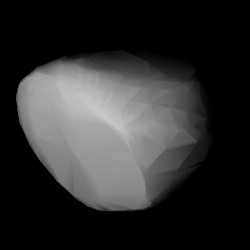 Ganymed is the largest of all near-Earth objects, but does not cross Earth's orbit. Ganymed has a MOID 0.3415 AU (51,000,000 km), or 133 lunar distances. Due to the high eccentricity of its orbit, Ganymed intersects the orbit of Mars at 1.66 AU.
Spectral measurements put Ganymed in the S (VI) spectral subtype,[13] indicating a surface rich in orthopyroxenes, and possibly metals (although if metals are present they are covered and not readily apparent in the spectra).
Ganymed is the largest of all near-Earth objects, but does not cross Earth's orbit. Ganymed has a MOID 0.3415 AU (51,000,000 km), or 133 lunar distances. Due to the high eccentricity of its orbit, Ganymed intersects the orbit of Mars at 1.66 AU.
Spectral measurements put Ganymed in the S (VI) spectral subtype,[13] indicating a surface rich in orthopyroxenes, and possibly metals (although if metals are present they are covered and not readily apparent in the spectra).
As the largest near-Earth object, Ganymed was quickly explored and settled after the First Interstellar War. A mining settlement and Unified Forces observation post and forward operating base were established on the asteroid.
The settlements, mining activities, and number of Variable Fighters deployed on Ganymed did not experience the rapid development seen in the other asteroid settlements. Conversely, it never underwent the subsequent bust that the other settlements experienced, either. The asteroid moderately expanded through the 20's and 30's, and then stagnated. Growth remained stable even after the development of the External Fold Booster in the late 30's—with only a small reduction in the number of VFs—and the introduction of Fold Wave Sensors in the 2050's.
By the 2070's, the Unified Government presence is limited to a listening post/inner solar system surveillance facilities, and a cluster of moderately sized mining settlements. The Unified Government facilities and forward deployed VFs are centred on Gottlob Airbase—also the location of the "main" starport—, and the mining and refining industries are centred on Soren and Jochen and their satellite towns and villages.
While the Unified Forces personnel assigned to Ganymed find it remote and boring, the civilian miners love the quiet and laid-back atmosphere that comes from being off the beaten track. The settlements are not self-sufficient, and rely on a steady flow of water, food, and other resources from the outside.
Orbit
no natural satellites
automated surveillance systems and beacons
A Northampton class Stealth Frigate makes semi-regular check-ups on Ganymed and other small settlements within the orbit of Mars. A bulk cargo transport ship visits on a regular schedule—to deliver supplies and pick-up minerals.
▲ Top ▶ Locations Index
Type: rocky planet
Size: 6,779±0.4 km (0.532 Earths)
Rotation: 1.027 days
Orbital period: 1.880 years at 1.523 (1.381 to 1.666) AU
Atmosphere: thin toxic
Water: frozen—in polar ice caps and underground
Orbit:
2 natural satellites
substantial Unified Government and Unified Forces presence
most settlements are underground to protect against solar wind, etc.
 Mars is the fourth planet from the Sun and the second-smallest planet in the Solar System, after Mercury. In English, it is often referred to as the 'Red Planet' due to the effect of the iron oxide prevalent on Mars' surface, which gives it a reddish appearance. Mars is a terrestrial planet with a thin atmosphere, having surface features reminiscent both of the impact craters of the Moon and the valleys, deserts, and polar ice caps of Earth.
The days and seasons are likewise comparable to those of Earth, because the rotational period, as well as the tilt of the rotational axis relative to the ecliptic plane are very similar. The lengths of the Martian seasons are about twice those of Earth's. Martian surface temperatures vary from lows of about -143°C at the winter polar caps, to highs of up to 35°C in equatorial summer. The wide range in temperatures is due to the thin atmosphere which cannot store much solar heat, the low atmospheric pressure, and the low thermal inertia of Martian soil. The planet is 1.52 times as far from the Sun as Earth, resulting in just 43% of the amount of sunlight.
Mars is the fourth planet from the Sun and the second-smallest planet in the Solar System, after Mercury. In English, it is often referred to as the 'Red Planet' due to the effect of the iron oxide prevalent on Mars' surface, which gives it a reddish appearance. Mars is a terrestrial planet with a thin atmosphere, having surface features reminiscent both of the impact craters of the Moon and the valleys, deserts, and polar ice caps of Earth.
The days and seasons are likewise comparable to those of Earth, because the rotational period, as well as the tilt of the rotational axis relative to the ecliptic plane are very similar. The lengths of the Martian seasons are about twice those of Earth's. Martian surface temperatures vary from lows of about -143°C at the winter polar caps, to highs of up to 35°C in equatorial summer. The wide range in temperatures is due to the thin atmosphere which cannot store much solar heat, the low atmospheric pressure, and the low thermal inertia of Martian soil. The planet is 1.52 times as far from the Sun as Earth, resulting in just 43% of the amount of sunlight.
The comparatively large eccentricity of the Martian orbit has a significant effect on seasons. Mars is near perihelion when it is summer in the southern hemisphere and winter in the north, and near aphelion when it is winter in the southern hemisphere and summer in the north. As a result, the seasons in the southern hemisphere are more extreme and the seasons in the northern are milder than would otherwise be the case.
Mars has the largest dust storms in the Solar System, reaching speeds of over 160 km/h. These can vary from a storm over a small area, to gigantic storms that cover the entire planet. They tend to occur when Mars is closest to the Sun, and have been shown to increase the global temperature.
Mars is the site of Olympus Mons, the largest volcano and highest known mountain in the Solar System, and of Valles Marineris, one of the largest canyons in the Solar System. The smooth Borealis basin in the northern hemisphere covers 40% of the planet and may be a giant impact feature.
There are ongoing investigations assessing the past habitability potential of Mars, as well as the possibility of extant life. Liquid water cannot exist on the surface of Mars due to low atmospheric pressure, which is less than 1% of the Earth's, except at the lowest elevations for short periods. The two polar ice caps appear to be made largely of water. The volume of water ice in the south polar ice cap, if melted, would be sufficient to cover the entire planetary surface to a depth of 11 m. In November 2016, NASA reported finding a large amount of underground ice in the Utopia Planitia region of Mars. The volume of water detected has been estimated to be equivalent to the volume of water in Lake Superior.
Magnetosphere and Atmosphere
Mars lost its magnetosphere 4 billion years ago, possibly because of numerous asteroid strikes, so the solar wind interacts directly with the Martian ionosphere, lowering the atmospheric density by stripping away atoms from the outer layer. The highest atmospheric density on Mars is equal to that found 35 km above Earth's surface.
The atmosphere of Mars consists of about 96% carbon dioxide. The atmosphere is quite dusty, containing particulates which give the Martian sky a tawny color when seen from the surface. It may take on a pink hue due to iron oxide particles suspended in it.
no bow shock
Settlements
Civilian Gov.:
Pop.: millions
Local Gov.: Unified Government
Main Leader(s): under investigation
Military:
Starport: good quality starport
Top military leader: under investigation
Ship deployed in emergencies: under investigation
Settlements:
H.G. Wells City (capital), pop. under investigation.
- Gamlin Kizaki born here on 2026.01.17.
Under investigation (2nd largest), pop. under investigation
Under investigation (3rd largest), pop. under investigation
Rural Settlements
Towns: under investigation
Villages: under investigation
Sera Base: permanent base
- construction begins in 2001.07.
- Manned by Unified Space Forces personnel from 2003.11 until 2005.08.
Orbit
Starbase: under investigation
Satellite Cities
Mars Defense Force fleet
Factory Satellites
Under investigation.
▲ Top ▶ Locations Index
Type: rocky satellite
Size: 27 x 22 x 18 km
Rotation: tidally locked (0.318 days)
Orbital period: 7 h 39 m at 9,376 (9,234 to 9,517) km; 2.76 Mars radii
Surface:
under investigation
Orbit:
under investigation
 Phobos orbits closer to its primary body than any other known planetary moon. It is so close that it orbits Mars much faster than Mars rotates. As a result, from the surface of Mars it appears to rise in the west, move across the sky in 4 hours and 15 minutes or less, and set in the east, twice each Martian day.
Surface temperatures range from about -4°C on the sunlit side to -112°C on the shadowed side. Stickney, a large impact crater that takes up a substantial proportion of the moon's surface, is the defining surface feature.
Many grooves and streaks also cover the oddly shaped surface. The grooves are typically less than 30 m deep, 100–200 m wide, and up to 20 km in length. The many grooves on Phobos were caused by boulders, ejected from the asteroid impact that created Stickney crater, that rolled in a predictable pattern on the surface of the moon.
Images and models indicate that Phobos may be a rubble pile held together by a thin crust, and that it is being torn apart by tidal interactions. Phobos gets closer to Mars by about 2 meters every one hundred years, and it is predicted that within 30 to 50 million years it will either collide with the planet, or break up into a planetary ring.
Phobos orbits closer to its primary body than any other known planetary moon. It is so close that it orbits Mars much faster than Mars rotates. As a result, from the surface of Mars it appears to rise in the west, move across the sky in 4 hours and 15 minutes or less, and set in the east, twice each Martian day.
Surface temperatures range from about -4°C on the sunlit side to -112°C on the shadowed side. Stickney, a large impact crater that takes up a substantial proportion of the moon's surface, is the defining surface feature.
Many grooves and streaks also cover the oddly shaped surface. The grooves are typically less than 30 m deep, 100–200 m wide, and up to 20 km in length. The many grooves on Phobos were caused by boulders, ejected from the asteroid impact that created Stickney crater, that rolled in a predictable pattern on the surface of the moon.
Images and models indicate that Phobos may be a rubble pile held together by a thin crust, and that it is being torn apart by tidal interactions. Phobos gets closer to Mars by about 2 meters every one hundred years, and it is predicted that within 30 to 50 million years it will either collide with the planet, or break up into a planetary ring.
▲ Top ▶ Locations Index
Type: rocky satellite
Size: 15 x 12.2 x 11 km
Rotation: tidally locked (1.263 days)
Orbital period: 1.263 days at 23,463.2 (23,455 to 23,470) km; 6.92 Mars radii
Surface:
under investigation
Orbit:
under investigation
 Deimos, like Phobos, has spectra, albedos, and densities similar to those of a C- or D-type asteroid. It is 56% of the size of Phobos. It is cratered, but the surface is noticeably smoother than that of Phobos, caused by the partial filling of craters with regolith.
Both Deimos and Phobos have very circular orbits which lie almost exactly in Mars's equatorial plane. Deimos rises in the east and sets in the west.
Because Deimos's orbit is relatively close to Mars and has only a very small inclination to Mars's equator, it cannot be seen from Martian latitudes greater than 82.7°. Deimos's orbit is slowly getting larger. It is expected to eventually escape Mars's gravity.
Deimos, like Phobos, has spectra, albedos, and densities similar to those of a C- or D-type asteroid. It is 56% of the size of Phobos. It is cratered, but the surface is noticeably smoother than that of Phobos, caused by the partial filling of craters with regolith.
Both Deimos and Phobos have very circular orbits which lie almost exactly in Mars's equatorial plane. Deimos rises in the east and sets in the west.
Because Deimos's orbit is relatively close to Mars and has only a very small inclination to Mars's equator, it cannot be seen from Martian latitudes greater than 82.7°. Deimos's orbit is slowly getting larger. It is expected to eventually escape Mars's gravity.
▲ Top ▶ Locations Index
The Mars trojans are a group of Trojan objects that share the orbit of the planet Mars around the Sun. They can be found around the two Lagrangian points 60° ahead of and behind Mars. The origin of the Mars trojans is not well understood.
The spectra of Eureka and two other Mars trojans indicates an olivine-rich composition. Since olivine-rich objects are rare in the asteroid belt, it has been suggested that some of the Mars trojans are captured debris from a large orbit-altering impact on Mars when it encountered a planetary embryo.
Due to close orbital similarities, most of the smaller members of the L5 group are hypothesized to be fragments of Eureka that were detached after it was spun up by the YORP effect (Eureka's rotational period is 2.69 h). The L4 trojan 1999 UJ7 has a much longer rotational period of ~50 h, apparently due to a chaotic rotation that prevents YORP spinup.
L4 (leading Lagrangian point)
Type: X-type asteroid
Size: ~1 km
Rotation: under investigation
Orbital period: 1.88 years at 1.524 (1.464 to 1.584) AU
Category: Mars trojan
As of September 2011, it is is the only known asteroid to orbit the leading L4 point of Mars. Not only does (121514) 1999 UJ7 orbit on the other side of Mars from other similar asteroids, its spectrum is different as well, which is puzzling because all of the Martian trojans seem to be in very stable orbits.
(121514) 1999 UJ7 orbits around the L4 point of Mars in a very stable orbit, and is large enough that the Yarkovsky effect will not affect its orbit.
L5 (trailing Lagrangian point)
Orbit: S/2011 (5261) 1
Size: 0.46 km
Rotation: under investigation
Orbital period: 0.705 days at 2.1 km.
Type: A-type asteroid
Size: 1.3 km
Rotation: 2.69 hours
Orbital period: 1.88 years at 1.523 (1.424 to 1.622) AU
Category: Mars trojan
The first Mars trojan discovered. It trails Mars at a distance varying by only 0.3 AU during each revolution. Minimum distances from Earth, Venus, and Jupiter, are 0.5, 0.8, and 3.5 AU, respectively.
Long-term numerical integration shows that the orbit is stable. Due to close orbital similarities, most of the other, smaller, members of the L5 group are hypothesized to be fragments of 5261 Eureka that were detached after it was spun up by the YORP effect (consistent with its rotational period of 2.69 h).
The asteroid is located deep within a stable Lagrangian zone of Mars, which is considered indicative of a primordial origin—meaning the asteroid has most likely been in this orbit for much of the history of the Solar System.
in a highly stable orbit
Type: S-type asteroid
Size: sub-kilometre
Rotation: 17.2 h
Orbital period: 1.88 years at 1.524 (1.371 to 1.677) AU
Category: Mars trojan
Observations indicate that it has a large proportion of metal and achondrites on its surface (either with or without a mesosiderite contribution); which could also indicate that the surface regolith has undergone space weathering. These observations also reveal differences in the spectra with 5261 Eureka, suggesting they may not be related to each other.
Type: under investigation
Size: 800–1,600 m
Rotation: under investigation
Orbital period: 1.88 years at 1.523 (1.441 to 1.606) AU
Category: Mars trojan
It is a stable L5 Mars Trojan asteroid with a libration period of 1,310 years. Its orbital values as well as its short-term orbital evolution are similar to those of 5261 Eureka. Out of all known Mars Trojans, it currently has the smallest relative (to Mars) semimajor axis.
Type: under investigation
Size: 562 m
Rotation: 3.97 h
Orbital period: 1.88 years at 1.523 (1.470 to 1.576) AU
Category: Mars trojan
It is a stable L5 Mars trojan with a libration period of 1,365 years. Its orbital values as well as its short-term orbital evolution are very similar to those of 5261 Eureka.
Type: under investigation
Size: 600 m
Rotation: under investigation
Orbital period: 1.88 years at 1.523 (1.456 to 1.591) AU
Category: Mars trojan
It is a stable L5 Mars trojan with a libration period of 1,300 years. Its orbital values as well as its short-term orbital evolution are very similar to those of 5261 Eureka.
Type: under investigation
Size: 560 m
Rotation: under investigation
Orbital period: 1.88 years at 1.523 (1.425 to 1.622) AU
Category: Mars trojan
It is a stable L5 Mars trojan with a libration period of 1,350 years. Its orbital values as well as its short-term orbital evolution are very similar to those of 5261 Eureka.
Type: under investigation
Size: 400 m
Rotation: under investigation
Orbital period: 1.88 years at 1.524 (1.425 to 1.623) AU
Category: Mars trojan
It is a stable L5 Mars trojan with a libration period of 1,430 years. The libration amplitude is not similar to that of 5261 Eureka and related objects.
Type: under investigation
Size: 400 m
Rotation: under investigation
Orbital period: 1.88 years at 1.523 (1.434 to 1.613) AU
Category: Mars trojan
It is a stable L5 Mars trojan. It may not be a member of the so-called Eureka family.
▲ Top ▶ Locations Index
REFERENCES
|
Wikipedia and the numerous contributors to it
Macross Compendium
The UNSDB's Colonies and Bases List by Daniel Henwood
Macross Chronicle. Tokyo: We've Inc., Aug. 2008–Jun. 2010.
Macross Chronicle Revised Ed. Tokyo: Deagostini, Jan. 2013–Aug. 2014.
"VF Evolutionary Theory." Great Mechanics.DX 9. Tokyo: Futabashi Co., Jun. 2009.
Macross Zero. Dir. Shoji Kawamori. DVD. Bandai Visual; Dec. 2002–Oct. 2004.
This Is Animation The Select: Super Dimensional Fortress Macross Vol. 1. Tokyo: Shogakukan, Feb. 1983
This Is Animation The Select: Super Dimensional Fortress Macross Vol. 2. Tokyo: Shogakukan, May. 1983
This Is Animation The Select: Super Dimensional Fortress Macross Vol. 3. Tokyo: Shogakukan, Sept. 1983
This Is Animation: Super Dimensional Fortress Macross Reference Materials - Complete Setting Collection 1. Tokyo: Shogakukan, Aug. 1983
This Is Animation: Super Dimensional Fortress Macross Reference Materials - Complete Setting Collection 2. Tokyo: Shogakukan, Oct. 1983
Macross Perfect Memory. Tokyo: Minori Library, Oct. 1984
This Is Animation The Select: Super Dimensional Fortress Macross Do You Remember Love? Tokyo: Shogakukan, Sept. 1984
Super Dimensional Fortress Macross Flashback 2012 Grafiti. Tokyo: Akita Shoten, Oct. 1987
Macross M3. Supervisor: Shoji Kawamori. GD-ROM. Shoeisha; Feb. 2001
This is Animation Special: Macross Plus The Movie. Tokyo: Shogakukan, Oct. 1995
This is Animation The Select: Macross Plus. Tokyo: Shogakukan, Mar. 1995
This is Animation: Macross 7 Animation Materials. Tokyo: Shogakukan, Jul. 1995
Fire Bomber In Macross 7 Official Program. Tokyo: Tokuma Shoten, Oct. 1995
Macross Digital Mission VF-X Official Program. Tokyo: Mediax, Marr. 1997
Macross Digital Mission VF-X Flight Manual. Tokyo: Shogakukan, Apr. 1997
Macross VF-X2 Fully Certified Strategy File. Tokyo: Kobunsha, Sept. 1999
|
Macross VF-X2 Official Visual Guide. Tokyo: Movic, Oct. 1999
Charaberry's Vol. 5. Tokyo: Enterbrain, Inc., Aug. 2008
Macross F 2059: Memories Tokyo: Kadokawa Shoten, Oct. 2008
Pash! Animation File 02 Macross Frontier Tokyo: Shufu To Seikatsu Sha, Jan. 2009
Macross F Ranka Lee Official Book Tokyo: Ohta Publishing, Nov. 2009
Macross Frontier Collection of Setting Data Blue. Tokyo: Movic, Oct. 2008
Macross Frontier Collection of Setting Data Red. Tokyo: Movic, Oct. 2008
Macross Frontier Offical File 1 Tokyo: Gakken, Oct. 2008
Macross Frontier Offical File 2 Tokyo: Gakken, Nov. 2008
Macross F Official Fan Book Tokyo: Gakken, Feb. 2009
Macross F The False Diva Guide Book Tokyo: Tokuma Shoten, Jan. 2010
Macross F The False Diva Roman Album Tokyo: Tokuma Shoten, Feb. 2010
Official Complete Book: Macross F Wings of Goodbye Tokyo: Kadokawa Shoten, Apr. 2011
Macross 30 Voices Across The Galaxy Visual Complete Guide Tokyo: Famitsu, Apr. 2013
Macross Delta. Dir. Shoji Kawamori. TV. Satelight; Apr. 2016–Sept. 2016.
Macross Delta Character Design Works. Tokyo: Ichijinasha, Dec. 2016
Variable Fighter Master File: VF-0 Pheonix. Tokyo: GA Graphic, Sep. 2012
Variable Fighter Master File: VF-1 Valkyrie. Tokyo: GA Graphic, Jul. 2009
Variable Fighter Master File: VF-1 Valkyrie Space Wings. Tokyo: GA Graphic, Dec. 2010
Variable Fighter Master File: VF-1 Valkyrie SDF-1 Macross VF-1 Squadrons. Tokyo: GA Graphic, Mar. 2014
Variable Fighter Master File: VF-1 Battroid Valkyrie. Tokyo: GA Graphic, Aug. 2018
Variable Fighter Master File: VF-1S Roy Focker Special. Tokyo: GA Graphic, Sept. 2020
Variable Fighter Master File: VF-4 Lightning III. Tokyo: GA Graphic, Aug. 2016
Variable Fighter Master File: VF-11 Thunderbolt. Tokyo: GA Graphic, Mar. 2019
Variable Fighter Master File: VF-19 Excalibur. Tokyo: GA Graphic, Jun. 2010
Variable Fighter Master File: VF-22 Sturmvögel II. Tokyo: GA Graphic, Sept. 2014
Variable Fighter Master File: VF-25 Messiah. Tokyo: GA Graphic, May. 2011
Variable Fighter Master File: VF-31 Siegfried. Tokyo: GA Graphic, Mar. 2017
|
 MAIN INDEX
MAIN INDEX MAIN INDEX
MAIN INDEX




